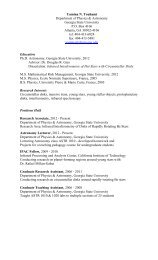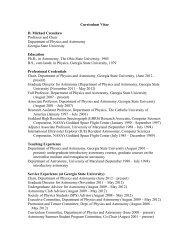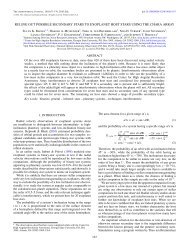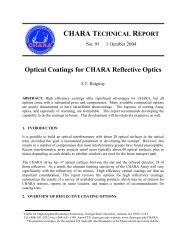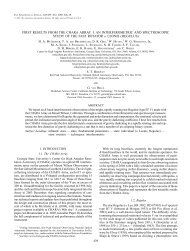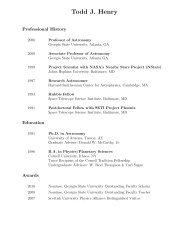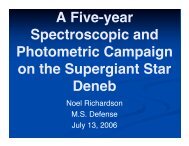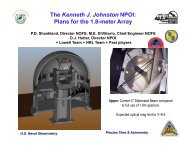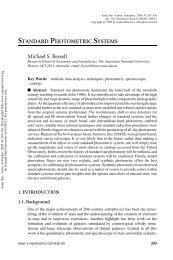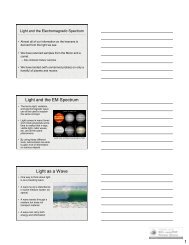the solar neighborhood. ix. hubble space telescope detections of ...
the solar neighborhood. ix. hubble space telescope detections of ...
the solar neighborhood. ix. hubble space telescope detections of ...
You also want an ePaper? Increase the reach of your titles
YUMPU automatically turns print PDFs into web optimized ePapers that Google loves.
The Astronomical Journal, 128:1733–1747, 2004 October<br />
# 2004. The American Astronomical Society. All rights reserved. Printed in U.S.A.<br />
THE SOLAR NEIGHBORHOOD. IX. HUBBLE SPACE TELESCOPE DETECTIONS OF COMPANIONS<br />
TO FIVE M AND L DWARFS WITHIN 10 PARSECS OF THE SUN<br />
David A. Golimowski, 1 Todd J. Henry, 2 John E. Krist, 3 Sergio Dieterich, 1 Holland C. Ford, 1 Garth D. Illingworth, 4<br />
David R. Ardila, 1 Mark Clampin, 5 Otto G. Franz, 6 Lawrence H. Wasserman, 6 G. Fritz Benedict, 7<br />
Barbara E. McArthur, 7 and Edmund G. Nelan 3<br />
Received 2004 May 17; accepted 2004 June 29<br />
ABSTRACT<br />
We report <strong>the</strong> <strong>detections</strong> <strong>of</strong> low-mass companions to five M and L dwarfs within 10 pc <strong>of</strong> <strong>the</strong> Sun using <strong>the</strong><br />
Hubble Space Telescope (HST ) Near-Infrared Camera and Multi-Object Spectrometer (NICMOS). Follow-up<br />
observations using <strong>the</strong> HST Advanced Camera for Surveys (ACS) and Fine Guidance Sensor 1r (FGS1r) confirm<br />
our NICMOS discoveries <strong>of</strong> companions to <strong>the</strong> L4.5 dwarf GJ 1001B (LHS 102B) and <strong>the</strong> M5 dwarf LHS 224,<br />
respectively. Images obtained with <strong>the</strong> Astrophysical Research Consortium 3.5 m <strong>telescope</strong> at Apache Point<br />
Observatory verify our discovery <strong>of</strong> a companion to <strong>the</strong> M3 dwarf G239-25. Our NICMOS images confirm <strong>the</strong><br />
previously suspected duplicity <strong>of</strong> <strong>the</strong> M3 dwarfs GJ 54 and GJ 84. The components <strong>of</strong> GJ 1001BC and LHS<br />
224AB have nearly equal luminosities in all <strong>the</strong> ACS and/or NICMOS bandpasses in which <strong>the</strong>y were observed.<br />
The magnitudes <strong>of</strong> GJ 54A and B in one FGS1r bandpass and four NICMOS bandpasses differ by P1. GJ 84B<br />
and G239-25B are 4 mag fainter than <strong>the</strong>ir M3 companions in <strong>the</strong> NICMOS bandpasses. We estimate from our<br />
NICMOS photometry that GJ 84B and G239-25B have spectral types M7 and M8, respectively, and masses near<br />
<strong>the</strong> lower limit for sustained hydrogen burning. The apparent separations <strong>of</strong> GJ 1001BC, GJ 54AB, and LHS<br />
224AB suggest orbital periods less than 5 yr. These binary dwarfs are ideal candidates for continued astrometric<br />
monitoring that will quickly yield accurate dynamic masses needed to constrain <strong>the</strong> mass-luminosity relation for<br />
low-mass stars and brown dwarfs.<br />
Key words: binaries: close — stars: individual (G239-25AB, GJ 1001ABC, GJ 54AB, GJ 84AB,<br />
LHS 224AB) — stars: low-mass, brown dwarfs<br />
1. INTRODUCTION<br />
Despite <strong>the</strong>ir proximity, <strong>the</strong> stars within 10 pc <strong>of</strong> <strong>the</strong> Sun<br />
remain an incompletely characterized population. This assessment<br />
is especially true for very low mass (VLM; M P<br />
0:20 M ) dwarfs, whose low luminosities (L P 10 2:5 L )retard<br />
comprehensive studies <strong>of</strong> <strong>the</strong>ir intrinsic properties and<br />
numerical abundance. For example, <strong>the</strong> empirical massluminosity<br />
relation (MLR) for late-M dwarfs is only sparsely<br />
sampled (Henry & McCarthy 1990, 1993; Henry et al. 1999;<br />
Delfosse et al. 2000), and its extension to <strong>the</strong> cooler L and T<br />
dwarfs is completely uncharted. In addition, <strong>the</strong> luminosity<br />
function (LF) <strong>of</strong> <strong>the</strong> nearest VLM stars is unsettled, as M<br />
dwarfs within 10 pc continue to be identified as companions<br />
(Golimowski et al. 1995; Gizis & Reid 1996; Delfosse et al.<br />
1999; Oppenheimer et al. 2001; this paper) and in isolation<br />
(Henry et al. 1997; Scholz et al. 2001; McCaughrean et al.<br />
2002; Reid et al. 2003; Teegarden et al. 2003; Hambly et al.<br />
2004). Only by exhaustively searching for faint nearby stars<br />
and closely separated companions can <strong>the</strong> MLR and LF be<br />
1 Department <strong>of</strong> Physics and Astronomy, Johns Hopkins University, 3400<br />
North Charles Street, Baltimore, MD 21218-2686.<br />
2 Department <strong>of</strong> Physics and Astronomy, Georgia State University, Atlanta,<br />
GA 30303-3083.<br />
3 Space Telescope Science Institute, 3700 San Martin Drive, Baltimore, MD<br />
21218.<br />
4 Lick Observatory, University <strong>of</strong> California at Santa Cruz, 1156 High<br />
Street, Santa Cruz, CA 95064.<br />
5 NASA/Goddard Space Flight Center, Code 681, Greenbelt, MD 20771.<br />
6 Lowell Observatory, 1400 West Mars Hill Road, Flagstaff, AZ 86001.<br />
7 McDonald Observatory, University <strong>of</strong> Texas, Austin, TX 78712-1083.<br />
1733<br />
sufficiently well determined to yield a definitive mass function<br />
<strong>of</strong> VLM stars and brown dwarfs.<br />
Since 1997 July we have conducted a ‘‘snapshot’’ search<br />
for VLM companions to all known stars within 10 pc <strong>of</strong> <strong>the</strong><br />
Sun using <strong>the</strong> Hubble Space Telescope (HST ) Near-Infrared<br />
Camera and Multi-Object Spectrometer (NICMOS). Our search<br />
spans <strong>the</strong> circumstellar region 0B2–10 00 from each target star,<br />
which corresponds to 2–100 AU for <strong>the</strong> most distant stars<br />
in our sample. This region bridges <strong>the</strong> 0–10 AU search <strong>space</strong>s<br />
<strong>of</strong> speckle-interferometry and radial-velocity surveys (Henry<br />
& McCarthy 1990; Leinert et al. 1997; Marcy & Butler 1998;<br />
Marcy et al. 2000) and <strong>the</strong> 100–1000 AU search <strong>space</strong>s <strong>of</strong><br />
deep, near-infrared imaging surveys (Skrutskie et al. 1989;<br />
Simons et al. 1996; Kirkpatrick et al. 2001; Wilson et al. 2001;<br />
Hinz et al. 2002; McCarthy & Zuckerman 2004). With ultimate<br />
detection limits <strong>of</strong> M J 21 and M K 19:5 at10pc<br />
(Krist et al. 1998), our NICMOS search is sensitive to companions<br />
that are at least 10 mag fainter than <strong>the</strong> empirical end<br />
<strong>of</strong> <strong>the</strong> hydrogen-burning main sequence (Henry & McCarthy<br />
1993) and at least 6 mag fainter than <strong>the</strong> archetypal T dwarf,<br />
GJ 229B (Mat<strong>the</strong>ws et al. 1996; Leggett et al. 2002a).<br />
The targets in our NICMOS snapshot program have been<br />
observed sporadically over 7 yr to fill small (20 minute)<br />
gaps in <strong>the</strong> HST observing schedule. To date, single-epoch<br />
images <strong>of</strong> 239 stars in 191 systems have been recorded. These<br />
observations represent 72% <strong>of</strong> <strong>the</strong> HST pointings required<br />
to survey all <strong>the</strong> stars and brown dwarfs within 10 pc identified<br />
astrometrically before 2004 January 1. (We treat known<br />
systems with separations less than 4 00 as individual HST targets.)<br />
In this paper—<strong>the</strong> ninth <strong>of</strong> <strong>the</strong> ‘‘Solar Neighborhood’’<br />
series produced by <strong>the</strong> Research Consortium on Nearby Stars
1734<br />
GOLIMOWSKI ET AL.<br />
(RECONS) 8 —we report <strong>the</strong> discoveries <strong>of</strong> VLM companions<br />
to three nearby M and L dwarfs (G239-25, GJ 1001B, and<br />
LHS 224), and we confirm companions to two o<strong>the</strong>r M dwarfs<br />
(GJ 54 and GJ 84). All but one <strong>of</strong> <strong>the</strong>se binary dwarfs have<br />
projected separations less than 5 AU. We discuss <strong>the</strong> potential<br />
impact <strong>of</strong> <strong>the</strong>se companions on <strong>the</strong> MLR, and we update <strong>the</strong><br />
state <strong>of</strong> multiplicity among presently known members <strong>of</strong><br />
<strong>the</strong> RECONS ‘‘10 pc sample.’’<br />
2. OBSERVATIONS AND DATA PROCESSING<br />
Table 1 contains basic information about <strong>the</strong> five M and L<br />
dwarfs to which we report newly discovered or confirmed<br />
VLM companions. Information about GJ 1001A (also known<br />
as LHS 102A) is also included to provide a full description <strong>of</strong><br />
<strong>the</strong> GJ 1001 system. Table 2 is a log <strong>of</strong> initial and follow-up<br />
observations <strong>of</strong> each dwarf conducted with NICMOS, <strong>the</strong> HST<br />
Advanced Camera for Surveys (ACS) and Fine Guidance<br />
Sensor 1r (FGS1r), and <strong>the</strong> Astrophysical Research Consortium<br />
(ARC) 3.5 m <strong>telescope</strong> at Apache Point Observatory<br />
(APO). We now describe <strong>the</strong>se observations in detail.<br />
2.1. NICMOS Observvations<br />
Each dwarf was observed at a single epoch with NICMOS<br />
Camera 2 (NIC2), which has a p<strong>ix</strong>el scale <strong>of</strong> 0B076 and a field<br />
<strong>of</strong>view(FOV)<strong>of</strong>19B5 ; 19B5 (Roye et al. 2003). The dwarfs<br />
were acquired as close to <strong>the</strong> center <strong>of</strong> <strong>the</strong> NIC2 field as <strong>the</strong><br />
uncertainties in <strong>the</strong>ir coordinates and proper motions allowed.<br />
Images were recorded in fine-guidance mode through <strong>the</strong><br />
F110W, F180M, F207M, and F222M filters (Table 3), which<br />
alternately sample <strong>the</strong> 1–2.5 m spectra <strong>of</strong> putative brown<br />
dwarf companions outside and inside <strong>the</strong> CH 4 absorption<br />
bands at 1.6–1.8 and 2.2–2.4 m. Figures 1a and 1b show<br />
that this combination <strong>of</strong> filters permits easy discrimination <strong>of</strong><br />
late M, L, and T dwarfs from most background stars. We use<br />
this color discrimination and expectations based on Galactic<br />
latitude to identify candidate VLM companions among <strong>the</strong><br />
many faint sources <strong>of</strong>ten imaged in a target field.<br />
Images through each filter were recorded using NICMOS’s<br />
multiple-accumulate (MULTIACCUM) mode, which allows<br />
<strong>the</strong> detector to be read nondestructively in predefined sampling<br />
sequences. Two sets <strong>of</strong> exposures totalling 64 s were<br />
recorded through each <strong>of</strong> <strong>the</strong> F110W and F180M filters, and<br />
two sets <strong>of</strong> exposures totalling 128 s were recorded through<br />
each <strong>of</strong> <strong>the</strong> F207M and F222M filters. All sets <strong>of</strong> exposures<br />
were recorded using a logarithmic sampling sequence that<br />
provides large dynamic range among <strong>the</strong> constituent images.<br />
The images were reduced using <strong>the</strong> standard NICMOS calibration<br />
s<strong>of</strong>tware (Dickinson et al. 2002) and appropriate reference<br />
images and tables. The calibration s<strong>of</strong>tware combines<br />
<strong>the</strong> constituent images <strong>of</strong> each sampling sequence so that<br />
values <strong>of</strong> p<strong>ix</strong>els ultimately affected by cosmic-ray impacts or<br />
saturation are replaced by appropriately scaled values <strong>of</strong> those<br />
p<strong>ix</strong>els sampled before <strong>the</strong> contaminating event. Consequently,<br />
<strong>the</strong> lost data in <strong>the</strong> reduced images are limited to intrinsically<br />
bad p<strong>ix</strong>els and/or p<strong>ix</strong>els that were saturated before <strong>the</strong> first<br />
nondestructive read <strong>of</strong> <strong>the</strong> detector (i.e., within <strong>the</strong> first 0.303 s<br />
<strong>of</strong> <strong>the</strong> exposure). Figure 2 shows <strong>the</strong> set <strong>of</strong> reduced and calibrated<br />
images obtained for a typical target, namely, <strong>the</strong> binary<br />
M dwarf GJ 84AB.<br />
8 Information about RECONS is currently available on <strong>the</strong> World Wide<br />
Web at http://www.chara.gsu.edu/RECONS.<br />
To facilitate <strong>the</strong> detection <strong>of</strong> faint companions in <strong>the</strong> reduced<br />
images, we subtracted <strong>the</strong> point-spread functions<br />
(PSFs) <strong>of</strong> <strong>the</strong> target stars in <strong>the</strong> manner described by Krist<br />
et al. (1998). First, we selected reference PSFs for each target<br />
and filter from <strong>the</strong> large collection <strong>of</strong> single-star images<br />
recorded during our snapshot survey. The reference PSFs for<br />
a given target were those that best matched not only <strong>the</strong><br />
brightness, spectral type, and field position <strong>of</strong> <strong>the</strong> target, but<br />
also <strong>the</strong> location <strong>of</strong> NIC2’s migratory cold mask at <strong>the</strong> time <strong>of</strong><br />
<strong>the</strong> observation. The reference PSFs were <strong>the</strong>n iteratively<br />
shifted, scaled, and subtracted from <strong>the</strong> target images until<br />
<strong>the</strong> residuals were visually minimized. Figure 3 shows <strong>the</strong><br />
results <strong>of</strong> this technique for <strong>the</strong> images <strong>of</strong> GJ 84AB shown in<br />
Figure 2. Our imaging and processing strategies yield sensitivities<br />
to faint companions that are dependent on <strong>the</strong> brightness<br />
<strong>of</strong> <strong>the</strong> target, <strong>the</strong> quality <strong>of</strong> <strong>the</strong> PSF subtraction, and <strong>the</strong><br />
field position. Krist et al. (1998) reported our detection limits<br />
at various angular distances from representative targets whose<br />
PSF-subtracted images are <strong>of</strong> average quality.<br />
We measured <strong>the</strong> apparent magnitudes <strong>of</strong> unsaturated and<br />
well-separated targets and field sources using conventional<br />
aperture photometry. To convert instrumental count rates to<br />
Vega-based magnitudes, we used aperture corrections computed<br />
for our selection <strong>of</strong> NICMOS filters (Krist et al. 1998)<br />
and <strong>the</strong> conversion recipe described in <strong>the</strong> HST Data Handbook<br />
for NICMOS (Dickinson et al. 2002):<br />
m ¼<br />
n<br />
2:5 log PHOTFNU ; CR ; ½F (Vega)Š<br />
1<br />
o<br />
þ ZP(Vega);<br />
ð1Þ<br />
where PHOTFNU is <strong>the</strong> bandpass-averaged flux density for a<br />
source producing a count rate <strong>of</strong> 1 DN s 1 , CR is <strong>the</strong> count<br />
rate (in DN s 1 ) <strong>of</strong> <strong>the</strong> observed source measured for an infinite<br />
aperture, F (Vega) is <strong>the</strong> flux <strong>of</strong> a zero magnitude star<br />
with a Vega-like spectrum, and ZP(Vega) ¼ 0:02 is <strong>the</strong> magnitude<br />
<strong>of</strong> Vega in all NICMOS bandpasses (Campins et al.<br />
1985). Table 3 lists <strong>the</strong> values <strong>of</strong> PHOTFNU and F (Vega)<br />
adopted for images obtained before and after <strong>the</strong> installation<br />
<strong>of</strong> <strong>the</strong> NICMOS Cooling System (NCS) in 2002 March.<br />
We computed <strong>the</strong> magnitudes <strong>of</strong> closely separated point<br />
sources from model NIC2 PSFs that were generated using <strong>the</strong><br />
Tiny Tim s<strong>of</strong>tware package (Krist & Hook 2003) and <strong>the</strong>n<br />
fitted to each overlapping image. 9 To verify <strong>the</strong> fidelity <strong>of</strong> this<br />
method, we compared <strong>the</strong> four-band magnitudes <strong>of</strong> 35–80<br />
single stars obtained from fitted Tiny Tim PSFs with those <strong>of</strong><br />
<strong>the</strong> same stars obtained via conventional aperture photometry.<br />
The fitted F207M and F222M magnitudes were, on average,<br />
indistinguishable from those obtained via aperture measurements.<br />
The fitted F110W and F180M magnitudes, however,<br />
differed from <strong>the</strong> aperture magnitudes by an average <strong>of</strong> +0.013<br />
and 0.022 mag, respectively. We <strong>the</strong>refore corrected <strong>the</strong><br />
F110W and F180M magnitudes <strong>of</strong> closely separated sources<br />
by subtracting <strong>the</strong>se average <strong>of</strong>fsets. The rms deviations between<br />
<strong>the</strong> model and aperture magnitudes <strong>of</strong> our single-star<br />
sample were 0.08 mag for F110W and only 0.03 mag for<br />
<strong>the</strong> o<strong>the</strong>r filters. This consistency encouraged us to estimate<br />
<strong>the</strong> magnitudes <strong>of</strong> overexposed targets using model PSFs<br />
9 We used model PSFs instead <strong>of</strong> natural reference PSFs because Tiny Tim<br />
produces oversampled images that can be more accurately fitted to <strong>the</strong> overlapping<br />
and undersampled NIC2 images. The model PSFs were generated with<br />
5 times <strong>the</strong> p<strong>ix</strong>el resolution <strong>of</strong> NIC2, aligned, and scaled to each imaged source<br />
and <strong>the</strong>n binned to <strong>the</strong> nominal NIC2 resolution to assess <strong>the</strong> quality <strong>of</strong> <strong>the</strong> fit.
TABLE 1<br />
Dwarfs with Newly Discovered or Confirmed Companions<br />
Name<br />
(1)<br />
R.A. (J2000.0)<br />
(2)<br />
Decl. (J2000.0)<br />
(3)<br />
b<br />
(deg)<br />
(4)<br />
(error) a<br />
(mas)<br />
(5)<br />
Proper Motion Photometry b References<br />
(arcsec yr 1 )<br />
(6)<br />
P.A. (deg)<br />
(7)<br />
SpT<br />
(8)<br />
K s<br />
(9)<br />
V<br />
(10)<br />
K s<br />
J<br />
(11)<br />
K s<br />
Coords.<br />
(12)<br />
<br />
(13)<br />
<br />
(14)<br />
SpT<br />
(15)<br />
GJ 1001A....... 00 04 36.4 40 44 03 73 104.7 (11.4) 1.618 154.5 M3.5 7.74 5.10 0.86 1 2 3 4<br />
GJ 1001B ....... 00 04 34.9 40 44 06 73 104.7 (11.4) 1.618 154.5 L4.5 11.40 ... 1.71 5 2 3 6<br />
GJ 54.............. 01 10 22.9 67 26 42 50 122.02 (6.04) 0.692 34.2 M3.0 5.13 4.67 0.88 7 2,7 7 8<br />
GJ 84.............. 02 05 04.8 17 36 53 71 106.37 (1.98) 1.329 97.5 M3.0 5.66 4.55 0.81 7 2,7 7 8<br />
LHS 224......... 07 03 55.9 +52 42 06 +23 108.5 (2.1) 1.166 141.7 M5.0 7.78 5.51 0.76 1 2 3 9<br />
G239-25 ......... 14 42 21.6 +66 03 21 +47 101.34 (12.77) 0.316 259.2 M3.0 6.49 4.34 0.81 7 7 7 3<br />
a Based on weighted mean <strong>of</strong> referenced trigonometric parallaxes.<br />
b J and K s from Two-Micron All Sky Survey (2MASS); V from Gliese & Jahreiss (1991) or Weis (1988, 1996).<br />
References.—(1) Bakos et al. 2002; (2) van Altena et al. 1995; (3) Gliese & Jahreiss 1991; (4) Martín et al. 1999; (5) 2MASS; (6) Leggett et al. 2002b; (7) ESA 1997; (8) Beaulieu et al.<br />
2004; (9) Reid et al. 1995.
1736 GOLIMOWSKI ET AL.<br />
Vol. 128<br />
TABLE 2<br />
Log <strong>of</strong> Observations<br />
Item GJ 1001A GJ 1001B GJ 54 GJ 84 LHS 224 G239-25<br />
Epoch 1<br />
Date ( UT)............ 1998 Aug 3 2002 Oct 11 1998 Nov 9 2002 Oct 2 2003 Mar 13 1998 Nov 7<br />
Telescope.............. HST HST HST HST HST HST<br />
Instrument ............ NIC2 NIC2 NIC2 NIC2 NIC2 NIC2<br />
Program No.......... 7894 9485 7894 9485 9485 7894<br />
Epoch 2<br />
Date ( UT)............ 2003 Aug 20 2003 Aug 20 2000 Sep 24 ... 2000 Jan 7 a 2003 May 6<br />
Telescope.............. HST HST HST ... HST ARC 3.5 m<br />
Instrument ............ ACS/HRC ACS/HRC FGS b ... FGS b SPICam<br />
Program No.......... 9990 9990 8729 ... 8532 ...<br />
a Observed in independent FGS search for multiplicity among nearby M dwarfs and white dwarfs.<br />
b Monitoring <strong>of</strong> orbit continues as part <strong>of</strong> HST Programs 9408, 9972, and 10104.<br />
fitted to <strong>the</strong> unsaturated parts <strong>of</strong> <strong>the</strong>ir images. We investigated<br />
this procedure using artificially saturated images <strong>of</strong> a wellexposed<br />
star. We found that <strong>the</strong> fitted PSFs yielded progressively<br />
fainter magnitudes as <strong>the</strong> numbers <strong>of</strong> saturated p<strong>ix</strong>els<br />
increased. Consequently, we adjusted <strong>the</strong> model magnitudes<br />
<strong>of</strong> actual saturated images to compensate for <strong>the</strong> deficiencies<br />
noted from our simulations. These adjustments ranged from<br />
0.01 mag for images with one saturated p<strong>ix</strong>el to 0.10 mag for<br />
images saturated within one Airy radius. The uncertainties <strong>of</strong><br />
<strong>the</strong> magnitudes <strong>of</strong> overexposed stars estimated in this manner<br />
are 0.02–0.25 mag.<br />
The locations <strong>of</strong> sources in <strong>the</strong> reduced images were determined<br />
from ei<strong>the</strong>r <strong>the</strong> centroids <strong>of</strong> <strong>the</strong> photometric apertures or<br />
<strong>the</strong> p<strong>ix</strong>el coordinates <strong>of</strong> <strong>the</strong> fitted model PSFs. We estimate that<br />
<strong>the</strong> uncertainties <strong>of</strong> <strong>the</strong> former method are 0.1 p<strong>ix</strong>el per axis<br />
and those <strong>of</strong> <strong>the</strong> latter method are 0.2 p<strong>ix</strong>el per axis for <strong>the</strong><br />
undersampled F110W images and 0.1 p<strong>ix</strong>el per axis for <strong>the</strong><br />
o<strong>the</strong>r filter images. (We double <strong>the</strong>se uncertainties for images<br />
affected by saturation or bad p<strong>ix</strong>els.) To determine <strong>the</strong> angular<br />
separations and position angles <strong>of</strong> <strong>the</strong> binary dwarfs, we<br />
adopted <strong>the</strong> x-axis and y-axis p<strong>ix</strong>el scales for NIC2 derived by<br />
<strong>the</strong> Space Telescope Science Institute (STScI) around <strong>the</strong> times<br />
<strong>of</strong> our observations. 10 We estimate that <strong>the</strong> nominal 1 00 uncertainty<br />
in <strong>the</strong> coordinates <strong>of</strong> HST guide stars contributes a<br />
negligible error <strong>of</strong> 0B6 to our computed position angles.<br />
10 The p<strong>ix</strong>el scales for each NICMOS camera are presently available on <strong>the</strong><br />
World Wide Web at http://www.stsci.edu/hst /nicmos/performance/platescale.<br />
Figure 4 shows representative NIC2 images <strong>of</strong> <strong>the</strong> five<br />
dwarfs for which we have detected new or suspected companions.<br />
The insets show magnified contour plots <strong>of</strong> <strong>the</strong> four<br />
systems separated by less than 0B5. GJ 1001BC, GJ 54AB, and<br />
LHS 224AB are only marginally resolved. The images <strong>of</strong> LHS<br />
224AB in all four bands are affected by bad NIC2 p<strong>ix</strong>els, and<br />
<strong>the</strong> F110W images <strong>of</strong> GJ 54AB and GJ 84A are saturated. The<br />
faint object located 1B74 to <strong>the</strong> sou<strong>the</strong>ast <strong>of</strong> GJ 1001BC is an<br />
extended source, presumably a background galaxy. Table 4<br />
lists <strong>the</strong> NICMOS magnitudes and relative positions <strong>of</strong> <strong>the</strong><br />
components <strong>of</strong> <strong>the</strong> five systems, which we determined in <strong>the</strong><br />
manners previously described. The magnitudes and colors <strong>of</strong><br />
<strong>the</strong>se dwarfs are depicted as filled circles in Figures 1a and 1b<br />
so that <strong>the</strong>y may be readily compared with <strong>the</strong> NICMOS<br />
photometry <strong>of</strong> o<strong>the</strong>r main-sequence stars and brown dwarfs.<br />
2.2. Follow-up Observvations<br />
Our NICMOS snapshot program is designed to be a singleepoch,<br />
multiband survey <strong>of</strong> all stars within 10 pc. Determining<br />
whe<strong>the</strong>r <strong>the</strong>se stars and any candidate companions have<br />
common proper motion (CPM) technically exceeds <strong>the</strong> scope<br />
<strong>of</strong> our program. Never<strong>the</strong>less, second-epoch observations <strong>of</strong><br />
candidate companions may be planned at <strong>the</strong> expense <strong>of</strong> unobserved<br />
targets. Only 50% <strong>of</strong> snapshot observations are<br />
likely to be executed during an HST observing cycle, however,<br />
so <strong>the</strong>se second-epoch observations are not guaranteed. Consequently,<br />
we sought more reliable means <strong>of</strong> confirming our<br />
candidates. We have confirmed four <strong>of</strong> <strong>the</strong> five candidate<br />
companions identified in this paper using two <strong>telescope</strong>s and<br />
TABLE 3<br />
NIC2 Exposure Characteristics<br />
Item F110W F180M F207M F222M<br />
Mean k ( m) ................................................. 1.1035 1.7971 2.0786 2.2164<br />
FWHM ( m) ................................................. 0.5915 0.0684 0.1522 0.1432<br />
MULTIACCUM sampling sequence a ............ STEP64 STEP64 STEP128 STEP128<br />
PHOTFNU ( Jy s DN 1 ;62K) b ................... 1.86394e-6 1.07637e-05 5.38945e-06 5.11497e-06<br />
PHOTFNU ( Jy s DN 1 ; 77.1 K) c ................. 1.2128 e-6 7.9701 e-06 4.2433 e-06 4.1897 e-06<br />
F ( Vega) ( Jy) ................................................ 1898 932 735 653<br />
a STEPn =0.3,0.6,1,2,4,8,:::, n (s).<br />
b Values before installation <strong>of</strong> NCS ( M. Dickinson 2004, personal communication).<br />
c Values after installation <strong>of</strong> NCS ( M. Dickinson 2004, personal communication).
No. 4, 2004<br />
THE SOLAR NEIGHBORHOOD. IX. 1737<br />
Fig. 1.—(a) NICMOS color-color diagram <strong>of</strong> F110W F180M vs. F180M F222M. (b) NICMOS color-magnitude diagram <strong>of</strong> M F110W vs. F110W F222M. In<br />
each diagram, open circles represent stars and brown dwarfs within 10 pc imaged in our snapshot survey. (Large circles: dwarfs with spectral types A through T;<br />
small circles: white dwarfs; concentric circles: subgiants.) Filled and enumerated circles depict <strong>the</strong> following components <strong>of</strong> systems reported in this paper:<br />
(1) GJ 84A, (2) GJ 54A, (3) GJ 54B, (4) G239-25A, (5) GJ 1001A, (6) LHS 224A, (7) LHS 224B, (8) GJ 84B, (9) G239-25B, (10) GJ 1001B, and (11) GJ 1001C.<br />
Typical measurement errors for <strong>the</strong>se nine dwarfs are shown in <strong>the</strong> bottom left corner <strong>of</strong> (a) and <strong>the</strong> top right corner <strong>of</strong> (b). The times and plus symbols represent<br />
syn<strong>the</strong>tic magnitudes and colors computed for L and T dwarfs, respectively. These values were obtained using flux-calibrated, near-infrared spectra (Geballe et al.<br />
2002; Knapp et al. 2004), weighted-mean trigonometric parallaxes (Golimowski et al. 2004 and references <strong>the</strong>rein), and <strong>the</strong> NICMOS Exposure Time Calculator<br />
produced by STScI.<br />
three instruments, none <strong>of</strong> which are NICMOS. We now describe<br />
<strong>the</strong>se confirmatory observations in chronological order.<br />
2.2.1. GJ 54AB and LHS 224AB<br />
The apparent separations and brightnesses <strong>of</strong> GJ 54AB<br />
and LHS 224AB (Table 4) make <strong>the</strong>m ideal targets for astrometric<br />
monitoring with HST’s FGS, which features whitelight<br />
shearing interferometers capable <strong>of</strong> measuring <strong>the</strong> positions<br />
<strong>of</strong> close binary systems with 0B001 precision (Nelan<br />
et al. 2003). GJ 54AB was observed with FGS1r in transfer<br />
(TRANS) mode on 2000 September 24 and 2003 June 13. The<br />
TRANS scans were recorded through <strong>the</strong> wide-band F583W<br />
filter. LHS 224AB was observed with <strong>the</strong> same instrument<br />
configuration on 2000 January 7 and 2003 October 30. The<br />
first FGS observation <strong>of</strong> LHS 224AB, which predates our<br />
NICMOS observation by 3 yr, was conducted as part <strong>of</strong> an<br />
independent FGS search for multiplicity among nearby M<br />
dwarfs and white dwarfs (HST Program 8532). Both binary<br />
systems continue to be monitored with FGS as parts <strong>of</strong> HST<br />
Programs 9408, 9972, and 10104. The complete results <strong>of</strong><br />
<strong>the</strong>se monitoring programs will be presented in subsequent<br />
papers. In <strong>the</strong> meantime, we present two-epoch results that<br />
support <strong>the</strong> duplicity <strong>of</strong> GJ 54 and LHS 224 inferred from our<br />
NIC2 images.<br />
The TRANS-mode observations <strong>of</strong> each binary star were<br />
calibrated and processed in <strong>the</strong> manner described by Franz<br />
et al. (1991). Figure 5 shows <strong>the</strong> transfer functions <strong>of</strong> GJ 54AB,<br />
LHS 224AB, and <strong>the</strong> single star HIP 28355, measured along<br />
orthogonal axes <strong>of</strong> FGS1r. These X and Y transfer functions<br />
track <strong>the</strong> visibility <strong>of</strong> <strong>the</strong> broadband fringes as <strong>the</strong> stars are<br />
scanned across <strong>the</strong> Koester’s prism (Franz et al. 1992). The<br />
transfer functions <strong>of</strong> a single star (left, Fig. 5) are generally<br />
antisymmetric about <strong>the</strong> zero scan position that denotes alignment<br />
between <strong>the</strong> incoming wave front and <strong>the</strong> optical axis. The<br />
transfer function <strong>of</strong> a binary star along a given FGS axis is <strong>the</strong><br />
superposition <strong>of</strong> <strong>the</strong> individual stars’ transfer functions, <strong>of</strong>fset<br />
by <strong>the</strong>ir projected separation along that axis. The transfer<br />
functions <strong>of</strong> LHS 224AB recorded on 2003 October 30 (right,<br />
Fig. 5) show that <strong>the</strong> binary star’s orientation was nearly parallel<br />
to <strong>the</strong> Y-axis <strong>of</strong> FGS1r and its separation was 0B16.<br />
Likewise, <strong>the</strong> middle panels <strong>of</strong> Figure 5 show that, on 2003<br />
June 13, GJ 54A and B were separated by 0B13 and were<br />
oriented obliquely to FGS1r’s X and Y axes.<br />
Decomposing <strong>the</strong> X and Y transfer functions <strong>of</strong> GJ 54AB<br />
and LHS 224AB into <strong>the</strong>ir constituent transfer functions<br />
allows us to determine <strong>the</strong> relative positions and F583W<br />
magnitudes <strong>of</strong> <strong>the</strong>ir components (Franz et al. 1991). Table 5<br />
lists our preliminary results. The differences between <strong>the</strong><br />
F583W magnitudes can be transformed to Johnson V-band<br />
magnitude differences (V ) in <strong>the</strong> manner described by<br />
Henry et al. (1999). Employing this technique, we estimate<br />
V ¼ 1:03 0:08 and 0:29 0:02 for GJ 54AB and LHS<br />
224AB, respectively. These values reflect <strong>the</strong> averages <strong>of</strong> <strong>the</strong><br />
measurements obtained along each FGS axis at two epochs<br />
<strong>of</strong> observation. Their errors include those associated with<br />
<strong>the</strong> deconvolution <strong>of</strong> <strong>the</strong> transfer functions, <strong>the</strong> photometric<br />
transformations, and <strong>the</strong> published parallaxes and composite V<br />
magnitudes <strong>of</strong> each system.<br />
2.2.2. G239-25AB<br />
Because <strong>the</strong> components <strong>of</strong> G239-25 are relatively bright<br />
and widely separated (Table 4), follow-up observations <strong>of</strong><br />
<strong>the</strong> system were possible using conventional ground-based<br />
imaging. We observed G239-25AB on 2003 May 6 using <strong>the</strong>
1738 GOLIMOWSKI ET AL.<br />
Vol. 128<br />
Fig. 2.—Reduced and calibrated NIC2 images <strong>of</strong> <strong>the</strong> binary M dwarf GJ 84AB. Each panel shows <strong>the</strong> full NIC2 FOV (19B5 ; 19B5) with logarithmic p<strong>ix</strong>el scaling.<br />
The saturated core <strong>of</strong> <strong>the</strong> F110W image is marked with black p<strong>ix</strong>els. The o<strong>the</strong>r black p<strong>ix</strong>els denote intrinsically bad p<strong>ix</strong>els and p<strong>ix</strong>els affected by instrumental debris<br />
(‘‘grot’’) that has settled on <strong>the</strong> detector. The diffuse disks in <strong>the</strong> upper left quadrants <strong>of</strong> <strong>the</strong> images are flat-field artifacts caused by NIC2’s coronagraphic hole. The<br />
M7 V companion (marked ‘‘B’’ in <strong>the</strong> top left panel ), which lies 0B44 from <strong>the</strong> primary star along <strong>the</strong> sou<strong>the</strong>ast diffraction spike, is barely seen amid <strong>the</strong> highly<br />
structured PSF <strong>of</strong> <strong>the</strong> primary star.<br />
ARC 3.5 m <strong>telescope</strong> and <strong>the</strong> Seaver Prototype Imaging<br />
Camera (SPICam), which features a 2048 ; 2048 p<strong>ix</strong>el CCD<br />
with an unbinned image scale <strong>of</strong> 0B141 p<strong>ix</strong>el 1 . Exposures<br />
<strong>of</strong> 1, 10, and 60 s were recorded using <strong>the</strong> Sloan Digital Sky<br />
Survey (SDSS) z filter and 2 ; 2 p<strong>ix</strong>el binning. The 1 s image<br />
<strong>of</strong> G239-25A was unsaturated and indicated a seeing-limited<br />
image resolution <strong>of</strong> 1B25. The sky transparency was variable,<br />
so no photometric calibration was possible. The images were<br />
reduced conventionally by subtracting <strong>the</strong> electronic bias and<br />
dividing by a flat-field image.<br />
Figure 6 shows a 14B4 ; 14B4 section <strong>of</strong> <strong>the</strong> reduced 1 s<br />
image centered on G239-25A. Part <strong>of</strong> <strong>the</strong> star’s seeing-limited<br />
PSF has been subtracted to reveal G239-25B more clearly.<br />
(Lacking a comparably exposed reference star, we subtracted<br />
artificial background values that were interpolated from radial<br />
pr<strong>of</strong>iles <strong>of</strong> <strong>the</strong> PSF at azimuths 45 from <strong>the</strong> position angle<br />
[P.A.] <strong>of</strong> G239-25B.) The companion is located 2B84 0B14<br />
from G239-25A at P:A: ¼ 106N5 3N6. The errors in <strong>the</strong>se<br />
values include a 0.5 p<strong>ix</strong>el uncertainty in each coordinate <strong>of</strong><br />
G239-25B’s centroid and a possible 0N4 errorin<strong>the</strong>alignment<br />
<strong>of</strong> SPICam’s detector with <strong>the</strong> celestial axes (R. McMillan<br />
2004, private communication). The integrated signals <strong>of</strong> each<br />
star within circular apertures <strong>of</strong> radius 0B85 (3 p<strong>ix</strong>els) indicate<br />
a magnitude difference <strong>of</strong> z 4:9.<br />
2.2.3. GJ 1001ABC<br />
A follow-up observation <strong>of</strong> <strong>the</strong> GJ 1001 triple system was<br />
performed on 2003 August 20 using <strong>the</strong> High Resolution<br />
Channel (HRC) <strong>of</strong> <strong>the</strong> HST ACS (Ford et al. 2003; Pavlovsky<br />
et al. 2003). 11 The HRC features a 1024 ; 1024 p<strong>ix</strong>el CCD<br />
with a p<strong>ix</strong>el scale <strong>of</strong> 0B025 ; 0B028. Its 26 00 ; 29 00 FOV<br />
11 This observation was conducted as part <strong>of</strong> <strong>the</strong> guaranteed observing time<br />
awarded to <strong>the</strong> ACS Investigation Definition Team.
No. 4, 2004<br />
THE SOLAR NEIGHBORHOOD. IX. 1739<br />
Fig. 3.—NIC2 images <strong>of</strong> GJ 84AB after optimal shifting, scaling, and subtraction <strong>of</strong> reference images <strong>of</strong> GJ 643 (M3.5 V) obtained on 2002 October 15. Each<br />
panel shows <strong>the</strong> full NIC2 FOV (19B5 ; 19B5) with logarithmic p<strong>ix</strong>el scaling. The top 27 rows <strong>of</strong> each image are unaltered by <strong>the</strong> PSF subtraction because GJ 643’s<br />
image was located 27 rows higher than GJ 84’s image. The M7 V companion (marked ‘‘B’’ in <strong>the</strong> top left panel ) is evident in each panel immediately to <strong>the</strong> east <strong>of</strong><br />
<strong>the</strong> central residuals <strong>of</strong> each subtracted PSF. No o<strong>the</strong>r sources appear in <strong>the</strong> FOV.<br />
allowed simultaneous imaging <strong>of</strong> all three components <strong>of</strong> <strong>the</strong><br />
system. Two sets <strong>of</strong> 2, 60, and 300 s exposures were recorded<br />
through <strong>the</strong> F850LP (SDSS z) filter to allow unsaturated imaging<br />
<strong>of</strong> each component. Between exposures, <strong>the</strong> <strong>telescope</strong><br />
was <strong>of</strong>fset by 6.5 p<strong>ix</strong>els along each CCD axis to diminish <strong>the</strong><br />
possibility <strong>of</strong> image corruption by bad p<strong>ix</strong>els. Likewise, two<br />
sets <strong>of</strong> 2 and 300 s exposures were recorded through <strong>the</strong><br />
F625W (SDSS r) and F775W (SDSS i) filters. All exposures<br />
were recorded using an analog-to-digital conversion gain <strong>of</strong><br />
2.2 e DN 1 . The digitized images were bias-subtracted and<br />
flattened using <strong>the</strong> standard ACS calibration s<strong>of</strong>tware (Mack<br />
et al. 2003) and appropriate reference images and tables. The<br />
flattened images were <strong>the</strong>n processed with <strong>the</strong> ACS Pipeline<br />
Science Investigation S<strong>of</strong>tware (APSIS; Blakeslee et al. 2003)<br />
to remove cosmic-ray contaminants, correct <strong>the</strong> images for<br />
geometric distortion, and combine <strong>the</strong> di<strong>the</strong>red pairs <strong>of</strong><br />
images. The reduced and resampled HRC images have rectified<br />
p<strong>ix</strong>el scales <strong>of</strong> 0B025 along each axis.<br />
Figure 7 shows <strong>the</strong> resultant 2 ; 300 s F775W image <strong>of</strong> GJ<br />
1001ABC. Although GJ 1001A is overexposed in this image,<br />
it is suitably exposed in our 2 s F775W images. These levels<br />
<strong>of</strong> exposure are also characteristic <strong>of</strong> <strong>the</strong> images obtained with<br />
<strong>the</strong> F625W and F850LP filters. The binary L dwarf is clearly<br />
resolved, and its photocenter lies 18B2 from GJ 1001A at<br />
P:A: 259 . These values are consistent with <strong>the</strong> relative<br />
positions <strong>of</strong> GJ 1001A and B reported by Goldman et al.<br />
(1999) from lower resolution, ground-based images in which<br />
GJ 1001A is overexposed.<br />
Although <strong>the</strong> angular resolution <strong>of</strong> <strong>the</strong> HRC at k ¼ 0:9 m<br />
is 2.2 times better than that <strong>of</strong> NIC2 at k ¼ 1:1 m, <strong>the</strong> HRC<br />
images <strong>of</strong> GJ 1001B and C overlap sufficiently to preclude<br />
<strong>the</strong> use <strong>of</strong> aperture photometry. Consequently, we generated<br />
model PSFs for each component using Tiny Tim (Krist &<br />
Hook 2003) and a reference spectrum <strong>of</strong> <strong>the</strong> L4 dwarf 2MASS<br />
J03454316+2540233 (Geballe et al. 2002). Because Tiny Tim<br />
produces only geometrically distorted PSFs, we fitted model
1740 GOLIMOWSKI ET AL.<br />
Vol. 128<br />
Fig. 4.—NIC2 images <strong>of</strong> <strong>the</strong> five dwarfs to which we have detected new or suspected companions. Each panel contains <strong>the</strong> filter image that most clearly shows<br />
<strong>the</strong> binary components. The full NIC2 FOV is displayed with logarithmic p<strong>ix</strong>el scaling, except where masked by labels and insets. The insets show magnified<br />
contour plots <strong>of</strong> <strong>the</strong> 13 ; 13 p<strong>ix</strong>el regions <strong>of</strong> each image centered on <strong>the</strong> close-binary dwarfs. Elongated contours indicate <strong>the</strong> orientations <strong>of</strong> <strong>the</strong> marginally resolved<br />
components. The images <strong>of</strong> GJ 84A and LHS 224AB are affected by overexposure and bad NIC2 p<strong>ix</strong>els, respectively. The faint object located 1B74 to <strong>the</strong> sou<strong>the</strong>ast<br />
<strong>of</strong> GJ 1001BC is an extended source, presumably a background galaxy.<br />
PSFs to <strong>the</strong> flattened but distorted (i.e., pre-APSIS) images <strong>of</strong><br />
GJ 1001B and C. Tiny Tim does not fully simulate <strong>the</strong> diffuse<br />
halo <strong>of</strong> scattered light that is superposed on point-source<br />
images longward <strong>of</strong> 0.8 m (Sirianni et al. 1998), so we<br />
derived approximate corrections for this effect in <strong>the</strong> F775W<br />
and F850LP bandpasses for each dwarf. In doing so, we<br />
normalized <strong>the</strong> integrated p<strong>ix</strong>el values from <strong>the</strong> PSFs fitted to<br />
<strong>the</strong> images <strong>of</strong> GJ 1001A with those obtained directly from <strong>the</strong><br />
APSIS-processed images using circular apertures with radii <strong>of</strong><br />
0B5 and <strong>the</strong> aperture corrections for M dwarfs reported by<br />
TABLE 4<br />
NICMOS Photometry and Astrometry <strong>of</strong> Multiple Systems<br />
Apparent Magnitude (error) a<br />
Separation (error)<br />
Name F110W F180M F207M F222M Method b Angular (arcsec) Projected (AU)<br />
P.A. (error) c<br />
(deg)<br />
GJ 1001A........ 8.89 (0.04) 7.97 (0.04) 7.86 (0.04) 7.72 (0.04) Aperture ... ... ...<br />
GJ 1001B ........ 14.50 (0.09) 12.86 (0.05) 12.47 (0.04) 12.04 (0.04) PSF Bfit 0.087 (0.006) 0.83 (0.11) 48.1 (5.2) d<br />
GJ 1001C ........ 14.60 (0.09) 13.00 (0.05) 12.31 (0.04) 12.05 (0.04) PSF Bfit ... ... ...<br />
GJ 54A............ 6.72 (0.12) 5.80 (0.05) 5.73 (0.05) 5.65 (0.05) PSF Bfit 0.129 (0.006) 1.05 (0.07) 284.9 (3.8)<br />
GJ 54B ............ 7.28 (0.12) 6.59 (0.05) 6.51 (0.05) 6.37 (0.05) PSF Bfit ... ... ...<br />
GJ 84A............ 6.38 (0.12) 5.75 (0.05) 5.55 (0.04) 5.57 (0.04) PSF Bfit 0.443 (0.006) 4.17 (0.10) 103.4 (1.0)<br />
GJ 84B ............ 10.97 (0.09) 9.76 (0.05) 9.73 (0.04) 9.39 (0.04) PSF Bfit ... ... ...<br />
LHS 224A....... 9.35 (0.12) 8.71 (0.09) 8.59 (0.09) 8.37 (0.09) PSF Bfit 0.132 (0.012) 1.21 (0.11) 14.0 (7.2)<br />
LHS 224B....... 9.36 (0.12) 8.88 (0.09) 8.75 (0.09) 8.51 (0.09) PSF Bfit ... ... ...<br />
G239-25A ....... 7.66 (0.09) 6.74 (0.05) 6.68 (0.05) 6.59 (0.05) PSF Bfit 3.041 (0.006) 30.01 (3.78) 114.0 (0.2)<br />
G239-25B........ 11.93 (0.04) 10.83 (0.04) 10.58 (0.04) 10.28 (0.04) Aperture ... ... ...<br />
a Errors include uncertainties in <strong>the</strong> following quantities, combined in quadrature (where applicable): photon noise, read noise, unsaturated PSF fits (3%–8%),<br />
PSF fits affected by saturation or bad p<strong>ix</strong>els (8%), absolute photometric calibration (
No. 4, 2004<br />
THE SOLAR NEIGHBORHOOD. IX. 1741<br />
Fig. 5.—Broadband ( F583W ) FGS1r transfer functions <strong>of</strong> <strong>the</strong> single star HIP 28355 ( left), <strong>the</strong> binary stars GJ 54AB (middle), and LHS 224AB (right). The<br />
observations <strong>of</strong> GJ 54AB and LHS 224AB were obtained on 2003 June 13 and 2003 October 30, respectively. The transfer functions <strong>of</strong> single stars are generally<br />
antisymmetric about <strong>the</strong> zero scan positions, with peak-to-peak amplitudes <strong>of</strong> 1.2; asymmetric and/or diminished transfer functions reflect <strong>the</strong> presence <strong>of</strong> a<br />
secondary component. For instance, <strong>the</strong> right panels show that LHS 224A and B differ in brightness by 0.3 mag and are separated by 0B03 and 0B16 along <strong>the</strong> X and<br />
Y axes, respectively.<br />
Sirianni et al. (2004). We <strong>the</strong>n applied <strong>the</strong> same normalization<br />
to <strong>the</strong> PSFs fitted to <strong>the</strong> images <strong>of</strong> GJ 1001B and C along with<br />
additional corrections <strong>of</strong> m F775W ¼ 0:008 and m F850LP ¼<br />
0:057 to compensate for <strong>the</strong> spectral differences between<br />
GJ 1001A and GJ 1001BC (Sirianni et al. 2004). We also<br />
applied small (1%) corrections for photometric losses<br />
caused by CCD charge-transfer inefficiency (Riess 2003). We<br />
estimate that <strong>the</strong> uncertainties <strong>of</strong> <strong>the</strong>se corrected count rates<br />
TABLE 5<br />
FGS Photometry and Astrometry <strong>of</strong> Binary M Dwarfs a<br />
Name F583W (error) Separation (arcsec)<br />
P.A.<br />
(deg)<br />
Epoch<br />
GJ 54AB .......... 1.040 (0.074) 0.11 93 2000.73<br />
0.13 283 2003.45<br />
LHS 224AB ..... 0.293 (0.006) 0.15 5 2000.02<br />
0.16 330 2003.83<br />
a Preliminary measurements <strong>of</strong> limited precision are given pending completion<br />
<strong>of</strong> <strong>the</strong> FGS monitoring programs. (See x 2.2.1.)<br />
are 4%–8%. We converted <strong>the</strong> count rates to AB and Vegabased<br />
magnitudes using <strong>the</strong> photometric calibration recipe<br />
<strong>of</strong> Sirianni et al. (2004), which specifies that Vega has zero<br />
magnitude in all bandpasses. Table 6 lists <strong>the</strong> resulting magnitudes<br />
and errors <strong>of</strong> GJ 1001ABC in each bandpass.<br />
To determine <strong>the</strong> relative separations and orientations <strong>of</strong> <strong>the</strong><br />
system components, we transformed <strong>the</strong> p<strong>ix</strong>el coordinates <strong>of</strong><br />
<strong>the</strong> fitted PSFs (which are measured from <strong>the</strong> geometrically<br />
distorted images) to angular coordinates measured along <strong>the</strong><br />
V2 and V3 axes that define HST ’s principal focal plane. In<br />
doing so, we used <strong>the</strong> latest image-distortion correction table<br />
(IDCTAB) for <strong>the</strong> HRC, which has an rms residual error <strong>of</strong><br />
0.03–0.05 p<strong>ix</strong>els per axis for <strong>the</strong> filters used in our study<br />
(Meurer et al. 2002). The errors in <strong>the</strong> measured centroids<br />
<strong>of</strong> our fitted PSFs are 0.1 p<strong>ix</strong>els, and <strong>the</strong> uncertainty in<br />
<strong>the</strong> orientation <strong>of</strong> <strong>the</strong> HRC FOV due to <strong>the</strong> 1 00 inaccuracy<br />
<strong>of</strong> HST guide star coordinates is 0B7. Columns (6)–(8) <strong>of</strong><br />
Table 6 list <strong>the</strong> apparent and projected separations and position<br />
angles <strong>of</strong> <strong>the</strong> GJ 1001 system, based on <strong>the</strong> average<br />
measurements from individual HRC images and <strong>the</strong> parallax<br />
given in Table 1. The first set <strong>of</strong> values pertains to <strong>the</strong>
1742 GOLIMOWSKI ET AL.<br />
Vol. 128<br />
Fig. 6.—Image <strong>of</strong> G239-25AB recorded through <strong>the</strong> SDSS z filter on 2003<br />
May 6 using <strong>the</strong> ARC 3.5 m <strong>telescope</strong> and SPICam at APO. This 14B4 ; 14B4<br />
region <strong>of</strong> <strong>the</strong> 1 s image is displayed with a linear scale and clipped at 1000 e<br />
to limit <strong>the</strong> dynamic range. The seeing-limited PSF <strong>of</strong> G239-25A has been<br />
partly subtracted to reveal more clearly <strong>the</strong> faint companion located 2B84 to<br />
<strong>the</strong> east-sou<strong>the</strong>ast.<br />
separation and orientation <strong>of</strong> <strong>the</strong> photocenter <strong>of</strong> GJ 1001BC<br />
with respect to GJ 1001A. The second set <strong>of</strong> values pertains to<br />
components B and C separately.<br />
3. DISCUSSION<br />
The PSF-subtracted NIC2 images <strong>of</strong> each dwarf reveal no<br />
sources o<strong>the</strong>r than <strong>the</strong> five companions and <strong>the</strong> single galaxy<br />
in <strong>the</strong> field <strong>of</strong> GJ 1001BC. The paucity <strong>of</strong> background sources<br />
is not surprising given <strong>the</strong> generally high Galactic latitudes <strong>of</strong><br />
<strong>the</strong> dwarfs (col. [4] <strong>of</strong> Table 1) and NIC2’s small FOV. Thus,<br />
<strong>the</strong> dwarfs’ high latitudes raise <strong>the</strong> likelihood that any apparent<br />
companions are true companions. Indeed, <strong>the</strong> high<br />
latitudes <strong>of</strong> <strong>the</strong>se dwarfs prompted <strong>the</strong>ir inclusion in this paper<br />
announcing <strong>the</strong> first confirmed companions <strong>of</strong> our NICMOS<br />
survey. We now discuss <strong>the</strong> evidence confirming <strong>the</strong>se companions<br />
and <strong>the</strong> implications for our future understanding<br />
<strong>of</strong> VLM multiple systems. We begin with GJ 1001BC, which<br />
is arguably <strong>the</strong> most significant <strong>of</strong> <strong>the</strong> newfound binaries<br />
from <strong>the</strong> perspective <strong>of</strong> constraining <strong>the</strong> MLR in <strong>the</strong> substellar<br />
regime.<br />
3.1. GJ 1001ABC<br />
Assuming that GJ 1001C is always <strong>the</strong> fainter <strong>of</strong> <strong>the</strong> closebinary<br />
components seen in our NIC2 and HRC images, <strong>the</strong>n<br />
GJ 1001C moved 0B07 at P:A: 164 relative to GJ 1001B<br />
during <strong>the</strong> 313 days between our epochs <strong>of</strong> observation. This<br />
motion is much less than that expected from <strong>the</strong> annual proper<br />
motion <strong>of</strong> <strong>the</strong> GJ 1001 system (1B618 at P:A: ¼ 154N5; van<br />
Altena et al. 1995). However, <strong>the</strong> NIC2 magnitudes <strong>of</strong> GJ<br />
1001B and C differ by amounts similar to <strong>the</strong>ir combined<br />
uncertainties, so <strong>the</strong>ir identities at each epoch are somewhat<br />
ambiguous. If we switch <strong>the</strong>ir identities in <strong>the</strong> NIC2 images,<br />
GJ 1001C moved 0B16 at P:A: 72 relative to GJ 1001B<br />
Fig. 7.—F775W (SDSS i) image <strong>of</strong> <strong>the</strong> GJ 1001 triple system obtained with<br />
<strong>the</strong> ACS HRC and processed by APSIS (see x 2.2.3). The rhomboidal image is<br />
a geometrically corrected composite <strong>of</strong> two di<strong>the</strong>red 300 s HRC exposures.<br />
The binary L dwarf GJ 1001BC lies 18B2 from <strong>the</strong> M3.5 primary star GJ<br />
1001A and 0B75 from <strong>the</strong> same anonymous galaxy seen in <strong>the</strong> NIC2 image<br />
( Fig. 4). No o<strong>the</strong>r sources appear in this high-latitude (b ¼ 73 )field.The<br />
inset shows a magnified and rescaled region centered on GJ 1001BC and<br />
<strong>the</strong> galaxy. The position angle <strong>of</strong> GJ 1001BC has changed significantly since<br />
<strong>the</strong> NIC2 observation <strong>of</strong> 2002 October 11.<br />
between our NICMOS and ACS observations. This motion is<br />
also much smaller and differently oriented than <strong>the</strong> annual<br />
proper motion <strong>of</strong> <strong>the</strong> GJ 1001 system. Conversely, <strong>the</strong> photocenter<br />
<strong>of</strong> GJ 1001BC moved 1B41 at P:A: ¼ 153N6 relative to<br />
<strong>the</strong> galaxy labeled in Figure 7, which is consistent with <strong>the</strong><br />
annual proper motion. We <strong>the</strong>refore conclude that GJ 1001A,<br />
B, and C have CPM regardless <strong>of</strong> how <strong>the</strong> components are<br />
labeled, and that <strong>the</strong> relative motion <strong>of</strong> GJ 1001B and C is<br />
orbital in nature.<br />
Using <strong>the</strong> observed separations <strong>of</strong> GJ 1001BC, a distance<br />
to<strong>the</strong>triplesystem<strong>of</strong>d ¼ 9:55 1:04 pc (van Altena et al.<br />
1995), and <strong>the</strong> statistical relation between <strong>the</strong> observed angular<br />
separation () and <strong>the</strong> semimajor axis <strong>of</strong> <strong>the</strong> relative<br />
orbit (a rel ),<br />
ha rel i¼1:26dhi<br />
(Fischer & Marcy 1992), we estimate that a rel 1:04 <br />
0:12 AU. The age <strong>of</strong> GJ 1001A is loosely constrained to 1–<br />
10 Gyr (Leggett et al. 2002b; Gizis et al. 2002), so we infer<br />
from evolutionary models (Burrows et al. 1997; Chabrier<br />
et al. 2000) that its coeval L4.5 dwarf companions (T eA <br />
1750 K; Golimowski et al. 2004) have masses <strong>of</strong> 0.06–<br />
0.075 M . If so, <strong>the</strong>n <strong>the</strong> period <strong>of</strong> GJ 1001BC’s orbit is<br />
2:9 0:5 yr, which is <strong>the</strong> shortest estimated period <strong>of</strong> any<br />
known binary L or T dwarf (Table 7). However, <strong>the</strong> 47 <br />
(clockwise) difference between <strong>the</strong> position angles <strong>of</strong> GJ<br />
1001C in <strong>the</strong> NIC2 and HRC images suggests ei<strong>the</strong>r that <strong>the</strong><br />
orbital period is actually much longer than 3 yr, or that GJ<br />
1001B and C are not consistently identified in <strong>the</strong> NIC2 and<br />
HRC images. If <strong>the</strong> identities <strong>of</strong> GJ 1001B and C in <strong>the</strong> NIC2<br />
ð2Þ
No. 4, 2004<br />
THE SOLAR NEIGHBORHOOD. IX. 1743<br />
TABLE 6<br />
ACS Photometry and Astrometry <strong>of</strong> <strong>the</strong> GJ 1001 System<br />
Name<br />
(1)<br />
F625W<br />
(2)<br />
Apparent Magnitude a (error) b<br />
F775W<br />
(3)<br />
F850LP<br />
(4)<br />
Method c<br />
(5)<br />
Angular<br />
(6)<br />
Separation (error)<br />
Projected (AU)<br />
(7)<br />
P.A. (error) d<br />
(deg)<br />
(8)<br />
GJ 1001A....... 12.11 (0.02) 10.67 (0.02) 9.94 (0.02) Aperture 18B236 (0B002) e 174.17 (18.96) e 258.8 (T0.1) e<br />
GJ 1001B ....... 20.80 (0.04) 18.35 (0.07) 16.42 (0.11) PSF Bfit 0B086 (0B002) 0.82 (0.09) 95.5 (0.5)<br />
GJ 1001C ....... 20.93 (0.04) 18.50 (0.07) 16.52 (0.11) PSF Bfit ... ... ...<br />
a AB magnitudes are given to permit comparison with SDSS r, i, andz photometry. To obtain Vega-based F625W, F775W, and F850LP magnitudes,<br />
subtract 0.167, 0.398, and 0.536, respectively, from <strong>the</strong> AB magnitudes listed in <strong>the</strong> table and convolve an additional error <strong>of</strong> 0.02 mag to account for <strong>the</strong><br />
uncertainty in <strong>the</strong> absolute flux calibration <strong>of</strong> Vega (Sirianni et al. 2004).<br />
b Photometric errors include uncertainties in <strong>the</strong> following quantities, combined in quadrature (where applicable): photon noise, read noise, PSF fitting<br />
(3%–10%), flat field (1%), instrument stability (0.5%), and charge-transfer inefficiency (1.5%).<br />
c Method for determining integrated count rates. (See x 2.2.3.)<br />
d Position angle measured east <strong>of</strong> north.<br />
e Separation and P.A. <strong>of</strong> GJ 1001BC’s photocenter with respect to GJ 1001A.<br />
images are switched, <strong>the</strong>n GJ 1001C’s position angle changed<br />
by 133 (counter-clockwise), which is more compatible with<br />
a 3 yr period than <strong>the</strong> motion inferred from our adopted<br />
designations <strong>of</strong> GJ 1001B and C.<br />
Since its discovery in 1999, GJ 1001B has been well<br />
studied photometrically and spectroscopically (Goldman et al.<br />
1999; Basri et al. 2000; Leggett et al. 2002b). As a companion<br />
to an M dwarf <strong>of</strong> known distance, it has frequently been used<br />
to study <strong>the</strong> relationships between <strong>the</strong> luminosities, colors, and<br />
spectral types <strong>of</strong> L dwarfs (Kirkpatrick et al. 2000; Dahn et al.<br />
2002; Knapp et al. 2004; Golimowski et al. 2004). None <strong>of</strong><br />
<strong>the</strong>se studies describes GJ 1001B as overluminous for its color<br />
or spectral type, as would be expected for a noneclipsed binary<br />
system with components <strong>of</strong> equal luminosity. The fact<br />
that GJ 1001BC is binary indicates that ei<strong>the</strong>r its components<br />
are underluminous or its inferred trigonometric parallax is<br />
incorrect. The composite optical and near-infrared spectra <strong>of</strong><br />
GJ 1001BC show that <strong>the</strong> components are typical mid-L dwarfs<br />
and reveal no cause for underluminosity in any optical or nearinfrared<br />
bandpass. Applying <strong>the</strong> SDSS color-magnitude relation<br />
<strong>of</strong> Hawley et al. (2002) to our ACS photometry <strong>of</strong> each<br />
component (Table 6), we compute an average photometric<br />
parallax <strong>of</strong> 0B046 0B017, or a distance to GJ 1001BC <strong>of</strong><br />
21:8 7:9 pc. Similarly applying <strong>the</strong> spectroscopic parallax<br />
relations <strong>of</strong> Hawley et al. (2002) for L4.5 dwarfs, we obtain<br />
distance moduli <strong>of</strong> M m 0:4 to 0.7, or d 12 14 pc.<br />
Although <strong>the</strong>se estimated photometric and spectroscopic distances<br />
agree only marginally, both suggest that <strong>the</strong> only published<br />
trigonometric parallax <strong>of</strong> GJ 1001A (van Altena et al.<br />
1995) is too large. Indeed, preliminary astrometric results for<br />
GJ 1001A from <strong>the</strong> Cerro Tololo Parallax Investigation indicate<br />
that <strong>the</strong> star’s distance is closer to 15 pc than to 10 pc<br />
(Henry et al. 2004).<br />
Assuming a revised distance <strong>of</strong> 15 pc to GJ 1001BC,<br />
we estimate that its relative orbit has a semimajor axis <strong>of</strong><br />
1.6 AU and a period <strong>of</strong> 5.5 yr. Unfortunately, <strong>the</strong> uncertainties<br />
associated with <strong>the</strong>se estimates prevent us from identifying<br />
GJ 1001B and C in <strong>the</strong> NIC2 images unambiguously.<br />
Regardless <strong>of</strong> <strong>the</strong> components’ designations, GJ 1001BC<br />
<strong>of</strong>fers a superb opportunity to determine <strong>the</strong> orbit and dynamical<br />
masses <strong>of</strong> two probable brown dwarfs in a small<br />
amount <strong>of</strong> time. Our HRC images show that HST can provide<br />
<strong>the</strong> high-resolution images necessary for such pioneering<br />
measurements, if its lifetime is extended by a fifth servicing<br />
mission. GJ 1001BC’s faintness and small separation pose<br />
a challenge for ground-based <strong>telescope</strong>s equipped with adaptive<br />
optics (AO), but <strong>the</strong> image resolution achieved during<br />
recent AO observations <strong>of</strong> <strong>the</strong> binary T dwarfs Indi BC<br />
TABLE 7<br />
Known Binary L and T Dwarfs with Periods P15 Yr<br />
Separation (error)<br />
References<br />
Dist.<br />
Period a<br />
Name SpT (pc) Ang. (arcsec) Proj. (AU) (yr) Image SpT <br />
GJ 1001BC ............................................. L4.5 + L4.5 9.6–15 .0.087 0.8–1.3 3–5.5 1 . .2 .3, 4<br />
2MASS J15344984 2952274AB .......... T5.5 + T5.5 .13.6 .0.065 0.9 3–5 5 . .5 . 6<br />
2MASSW J0920122+351742AB ........... L6.5 + L7.0 .20.8 b .0.070 1.5 6–10 7 . .7 . 7<br />
GJ 417BC c .............................................. L4.5 + L5.5 .21.7 .0.070 1.5 7–11 8 . .9 .10<br />
2MASS J07464256+2000321AB........... L0.0 + L1.5 .12.2 0.12–0.22 1.5–2.7 8–13 7, 11, 12 .12 .13<br />
GJ 564BC ............................................... L4.0 + L4.0 .17.9 .0.134 2.4 14–22 14 . .15 .10<br />
Indi BC................................................. T1.0 + T6.0 . 3.6 .0.732 2.6 15–25 16 . .16 .10<br />
a Periods <strong>of</strong> all binaries except 2MASS J0746+2000AB are estimated from eq. (2) and assumed masses <strong>of</strong> 0.030–0.075 M (0.060–0.075 M for GJ 1001BC;<br />
see text). 2MASS J0746+2000AB’s period was computed by Bouy et al. (2004) from a Keplerian fit to 60% <strong>of</strong> its orbit.<br />
b Estimated from photometric parallax.<br />
c Also known as 2MASS J1112257+354813AB.<br />
References.—(1) this paper; (2) Leggett et al. 2002b; (3) van Altena et al. 1995; (4) Henry et al. 2004; (5) Burgasser et al. 2003; (6) Tinney et al. 2003; (7) Reid et al.<br />
2001; (8) Bouy et al. 2003; (9) Kirkpatrick et al. 2000; (10) ESA 1997; (11) Close et al. 2003; (12) Bouy et al. 2004; (13) Dahn et al. 2002; (14) Potter et al. 2002;<br />
(15) Goto et al. 2002; (16) McCaughrean et al. 2004.
1744 GOLIMOWSKI ET AL.<br />
Vol. 128<br />
(McCaughrean et al. 2004) indicate that long-term monitoring<br />
<strong>of</strong> GJ 1001BC’s orbit should be possible with <strong>the</strong> latest<br />
ground-based imaging technology.<br />
3.2. GJ 54AB<br />
The suspected duplicity <strong>of</strong> GJ 54 was first reported by<br />
Rodgers & Eggen (1974), who visually observed a ‘‘very<br />
close double star <strong>of</strong> nearly equal components in <strong>the</strong> 40-inch<br />
reflector’’ at Siding Spring Observatory. They provided no<br />
information about <strong>the</strong> separation <strong>of</strong> <strong>the</strong> double star or <strong>the</strong><br />
epoch <strong>of</strong> <strong>the</strong>ir observation, but <strong>the</strong> lack <strong>of</strong> o<strong>the</strong>r stars <strong>of</strong><br />
comparable brightness within several arcminutes <strong>of</strong> GJ 54<br />
suggests that Rodgers & Eggen did observe <strong>the</strong> same pair <strong>of</strong><br />
stars seen in our NIC2 images. The V-band diffraction limit<br />
<strong>of</strong> a 40 inch (1 m) <strong>telescope</strong> is comparable to <strong>the</strong> separation <strong>of</strong><br />
GJ 54AB measured from our NIC2 and FGS data, so Rodgers<br />
& Eggen may have seen <strong>the</strong> pair during instances <strong>of</strong> excellent<br />
atmospheric seeing. Therefore, we credit Rodgers & Eggen<br />
(1974) with <strong>the</strong> initial discovery <strong>of</strong> GJ 54AB and reserve for<br />
ourselves <strong>the</strong> pleasure <strong>of</strong> confirming and quantifying that<br />
discovery.<br />
The FGS TRANS scans <strong>of</strong> GJ 54 recorded on 2000<br />
September 24 and 2003 June 13 (Fig. 5) show two components<br />
separated by 0B12 (Table 5). This separation is similar<br />
to that measured from our NIC2 images obtained on 1998<br />
November 9, and it is much less than GJ 54’s annual proper<br />
motion <strong>of</strong> 0B692 (ESA 1997). We <strong>the</strong>refore conclude that GJ<br />
54A and B exhibit CPM and are physically bound. Figures 1a<br />
and 1b show that <strong>the</strong> NIC2 magnitudes and colors <strong>of</strong> GJ 54A<br />
and B are consistent with o<strong>the</strong>r stars in our 10 pc sample<br />
having spectral types M2.0–M2.5 and M3.0, respectively.<br />
Using our computed value <strong>of</strong> V for GJ 54AB (x 2.2.1)<br />
and published measurements <strong>of</strong> <strong>the</strong> stars’ composite V magnitude<br />
and parallax (Table 1), we obtain M V ¼ 10:60 0:11<br />
and 11:63 0:12 for GJ 54A and B, respectively. Employing<br />
<strong>the</strong> V-band MLR <strong>of</strong> Delfosse et al. (2000), we compute masses<br />
<strong>of</strong> 0:42 0:07 and 0:31 0:07 M for <strong>the</strong> two stars.<br />
Using our HST measurements, a distance to GJ 54AB <strong>of</strong><br />
8:20 0:41 pc (Table 1), and equation (2), we estimate a<br />
semimajor axis <strong>of</strong> 1:33 0:09 AU and a period <strong>of</strong> 1:8 <br />
0:2 yr for GJ 54AB’s relative orbit. After deconvolving <strong>the</strong><br />
individual components <strong>of</strong> <strong>the</strong> FGS transfer functions and<br />
transforming <strong>the</strong>m to celestial positions, we find that <strong>the</strong> position<br />
<strong>of</strong> GJ 54B relative to GJ 54A on 2000 September 24<br />
was nearly coincident with <strong>the</strong> position observed in <strong>the</strong> NIC2<br />
images recorded 1.87 yr before. In fact, a preliminary fit <strong>of</strong><br />
a Keplerian orbit to our three-epoch astrometric measurements<br />
yields a highly inclined orbit with a semimajor axis <strong>of</strong><br />
0B17 (1.4 AU), a period <strong>of</strong> 1.75 yr, and masses <strong>of</strong> 0.49<br />
and 0.33 M . Thus, our crude photometric and astrometric<br />
estimates <strong>of</strong> <strong>the</strong> orbits and masses <strong>of</strong> GJ 54AB are mutually<br />
consistent.<br />
3.3. GJ 84AB<br />
Nidever et al. (2002) reported 11 radial-velocity measurements<br />
<strong>of</strong> GJ 84 obtained with <strong>the</strong> 10 m Keck I <strong>telescope</strong> from<br />
1998 February to 2001 July that indicate <strong>the</strong> presence <strong>of</strong> a<br />
low-mass companion. They reproduced <strong>the</strong> velocity variations<br />
by fitting a partial Keplerian orbit with a period <strong>of</strong> 19 7yr,a<br />
semiamplitude <strong>of</strong> 2:2 0:2 kms 1 , and an eccentricity <strong>of</strong><br />
0:44 0:08. They also estimated for <strong>the</strong> companion a minimum<br />
mass <strong>of</strong> 0.115 M and a minimum semimajor axis <strong>of</strong><br />
5.6 AU. These values are consistent with <strong>the</strong> luminosity and<br />
projected separation <strong>of</strong> <strong>the</strong> faint companion seen in our NIC2<br />
images (Table 4). Our images thus confirm <strong>the</strong> duplicity <strong>of</strong> GJ<br />
84 and are useful for fur<strong>the</strong>r constraining <strong>the</strong> parameters <strong>of</strong> <strong>the</strong><br />
binary orbit.<br />
Figure 1b shows that <strong>the</strong> values <strong>of</strong> M F110W ¼ 11:10 0:10<br />
and F110W F222M ¼ 1:58 0:10 measured for GJ 84B lie<br />
between those <strong>of</strong> <strong>the</strong> M7 dwarf GJ 105C (M F110W ¼ 10:93,<br />
F110W F222M ¼ 1:42; revised from Golimowski et al.<br />
2000) and <strong>the</strong> M8 dwarf GJ 752B (M F110W ¼ 11:59, F110W<br />
F222M ¼ 1:71). The anomalous location <strong>of</strong> GJ 84B’s colors<br />
in Figure 1a is likely due to a singularly large error in our<br />
F180M measurement caused by <strong>the</strong> coincidence <strong>of</strong> GJ 84B’s<br />
image and a diffraction spike from GJ 84A (Figs. 2 and 3). As<br />
<strong>the</strong> magnitudes and colors <strong>of</strong> GJ 84B generally match those <strong>of</strong><br />
GJ 105C within <strong>the</strong>ir combined uncertainties, we tentatively<br />
assign a spectral type <strong>of</strong> M7 to GJ 84B. To estimate <strong>the</strong> masses<br />
<strong>of</strong> GJ 84A and B from current near-infrared MLRs, we loosely<br />
equate our measured values <strong>of</strong> M F110W and 1 2 (M F207M þ<br />
M F222M ) for each star with its conventional J- andK-band<br />
absolute magnitude, respectively. Employing <strong>the</strong> MLRs <strong>of</strong><br />
Delfosse et al. (2000), we obtain masses <strong>of</strong> 0:51 0:06 and<br />
0:084 0:026 M for GJ 84A and B, respectively. Using<br />
<strong>the</strong>se masses, a distance to GJ 84AB <strong>of</strong> 9:40 0:17 pc<br />
(Table 1), <strong>the</strong> observed binary separation (Table 4), and<br />
equation (2), we estimate a semimajor axis <strong>of</strong> 5:25 0:12 AU<br />
and a period <strong>of</strong> 15:6 1:0 yr for GJ 84AB’s relative orbit.<br />
We can investigate <strong>the</strong> consistency between <strong>the</strong> orbital<br />
characteristics estimated from our NIC2 images and those<br />
derived by Nidever et al. (2002) from <strong>the</strong> Keplerian fit to <strong>the</strong>ir<br />
measured radial velocities. Kepler’s third law may be expressed<br />
as<br />
a 1<br />
abs<br />
¼ P 2=3 M 2<br />
(M 1 þ M 2 ) 2=3 ð3Þ<br />
(Lang 1980), where a 1 is <strong>the</strong> semimajor axis <strong>of</strong> <strong>the</strong> primary<br />
star’s orbit about <strong>the</strong> barycenter in units <strong>of</strong> arcseconds, abs is<br />
<strong>the</strong> absolute parallax, P is <strong>the</strong> orbital period expressed in<br />
years, and M 1 and M 2 are <strong>the</strong> primary and secondary masses in<br />
units <strong>of</strong> <strong>solar</strong> masses. Using our estimated masses <strong>of</strong> GJ 84A<br />
and B and <strong>the</strong> fitted radial-velocity period <strong>of</strong> Nidever et al.<br />
(2002), we obtain a 1 0B089 0B035. An equation relating<br />
orbital parameters derived astrometrically and spectroscopically<br />
(Lang 1980) can be expressed as<br />
a 1 sin i<br />
¼ PK pffiffiffiffiffiffiffiffiffiffiffiffi<br />
1 1 e 2<br />
abs 2 ; 4:7405 ;<br />
ð4Þ<br />
where i is <strong>the</strong> inclination <strong>of</strong> <strong>the</strong> orbit with respect to <strong>the</strong> line <strong>of</strong><br />
sight, K 1 is <strong>the</strong> semiamplitude <strong>of</strong> <strong>the</strong> primary star’s radialvelocity<br />
orbit in units <strong>of</strong> kilometers per second, e is <strong>the</strong> eccentricity<br />
<strong>of</strong> <strong>the</strong> orbit, and 3:14159. Inserting <strong>the</strong> values<br />
<strong>of</strong> a 1 , P, K 1 ,ande derived by Nidever et al. (2002) and us, we<br />
obtain sin i 1:49 0:85. Only <strong>the</strong> values <strong>of</strong> sin i deviating<br />
by more than 0.5 from 1.49 are physical, which indicates<br />
that <strong>the</strong> Keplerian fit to <strong>the</strong> radial velocity data is only marginally<br />
compatible with our observed luminosities (masses) <strong>of</strong><br />
GJ 84AB. Clearly, more spectroscopic and astrometric observations<br />
are needed over <strong>the</strong> next decade to better constrain<br />
<strong>the</strong> orbit <strong>of</strong> GJ 84AB.<br />
3.4. LHS 224AB<br />
The duplicity <strong>of</strong> LHS 224 was first suspected by Dahn et al.<br />
(1982), who noted a possible astrometric perturbation with a<br />
period <strong>of</strong> 6 yr from photographic plates produced by <strong>the</strong>
No. 4, 2004<br />
THE SOLAR NEIGHBORHOOD. IX. 1745<br />
United States Naval Observatory from 1969 to 1980. After<br />
ano<strong>the</strong>r decade <strong>of</strong> astrometric monitoring, Harrington et al.<br />
(1993) could nei<strong>the</strong>r confirm nor deny this suspicion. In 1999,<br />
LHS 224 was included in our ongoing FGS survey <strong>of</strong> nearby<br />
and possibly binary red and white dwarfs. The TRANS scans<br />
<strong>of</strong> LHS 224 recorded on 2000 January 7 and 2003 October 30<br />
(Fig. 5) show two components separated by 0B16 (Table 5).<br />
This separation is similar to that measured from our NIC2<br />
images obtained on 2003 March 13, and it is much less than<br />
LHS 224’s annual proper motion <strong>of</strong> 1B166 (Gliese & Jahreiss<br />
1991). We <strong>the</strong>refore conclude that LHS 224A and B exhibit<br />
CPM and are physically bound.<br />
Figures 1a and 1b suggest that <strong>the</strong> NIC2 F110W magnitudes<br />
and F110W F222M colors <strong>of</strong> LHS 224AB are brighter<br />
and bluer, respectively, than those <strong>of</strong> o<strong>the</strong>r M5 dwarfs. Such<br />
anomalous behavior is not seen in o<strong>the</strong>r color-magnitude and<br />
color-color diagrams constructed from our F180M, F207M,<br />
and F222M photometry <strong>of</strong> nearby stars. We <strong>the</strong>refore suspect<br />
that our F110W measurements are adversely affected by <strong>the</strong><br />
undersampled F110W images <strong>of</strong> LHS 224AB and by <strong>the</strong> unfortunate<br />
proximity <strong>of</strong> bad p<strong>ix</strong>els to those images (Fig. 4). The<br />
magnitudes and colors <strong>of</strong> LHS 224A and B measured in <strong>the</strong><br />
o<strong>the</strong>r bandpasses are consistent with those <strong>of</strong> several nearby<br />
dwarfs having types M4.5–M5.0 and M5.0–M5.5, respectively.<br />
Using our computed value <strong>of</strong> V for LHS 224AB<br />
(x 2.2.1) and published measurements <strong>of</strong> <strong>the</strong> stars’ composite<br />
V magnitude and parallax (Table 1), we obtain M V ¼ 14:08 <br />
0:05 and 14:37 0:05 for LHS 224A and B, respectively.<br />
Employing <strong>the</strong> V-band MLR <strong>of</strong> Delfosse et al. (2000), we<br />
compute masses <strong>of</strong> 0:16 0:02 and 0:14 0:02 M for <strong>the</strong><br />
two stars.<br />
Using our NIC2 measurements, a distance to LHS 224AB<br />
<strong>of</strong> 9:2 0:2 pc (van Altena et al. 1995), and equation (2), we<br />
estimate a rel 1:53 0:08 AU and P 3:5 0:3yrforLHS<br />
224AB’s orbit. A preliminary fit <strong>of</strong> a Keplerian orbit to our<br />
three-epoch astrometric measurements yields a rel 1:6 AU,<br />
P 3:3 yr, and masses <strong>of</strong> 0.21 and 0.20 M .Thesedynamic<br />
masses exceed our photometric estimates by 3 ,butwe<br />
expect <strong>the</strong>se discrepancies to diminish greatly as more FGS<br />
measurements are obtained over a broader range <strong>of</strong> orbital<br />
phases.<br />
3.5. G239-25AB<br />
During <strong>the</strong> 4.5 yr between our NIC2 and SPICam observations,<br />
G239-25A’s proper motion was 1B42 toward P:A: ¼<br />
259N2 (ESA 1997). The magnitude and direction <strong>of</strong> this motion<br />
are inconsistent with <strong>the</strong> small differences between <strong>the</strong><br />
relative positions <strong>of</strong> G239-25A and B at each epoch. We<br />
<strong>the</strong>refore conclude that G239-25A and B have CPM and are<br />
gravitationally bound. Moreover, we believe that <strong>the</strong> observed<br />
motion <strong>of</strong> G239-25B relative to G239-25A (0B43 0B14 toward<br />
P:A: ¼ 352 22 ) is orbital in nature.<br />
Figures 1a and 1b show that <strong>the</strong> NIC2 magnitudes and<br />
colors <strong>of</strong> G239-25B are similar to those <strong>of</strong> <strong>the</strong> M8 dwarf GJ<br />
752B and <strong>the</strong> spectroscopically unclassified late M dwarf GJ<br />
1245C. The latter dwarf is <strong>the</strong> least massive M dwarf (0:074 <br />
0:013 M ; Henry et al. 1999) for which a mass has been<br />
computed exclusively from dynamical elements. 12 We assume<br />
for our present purpose that G239-25B has <strong>the</strong> same spectral<br />
12 Lane et al. (2001) mapped <strong>the</strong> relative orbit <strong>of</strong> <strong>the</strong> M8.5+M9 dwarf<br />
binary GJ 569BC and derived a total mass <strong>of</strong> 0:123 0:025 M for <strong>the</strong> two<br />
dwarfs. Lacking a dynamical measurement <strong>of</strong> <strong>the</strong> components’ mass ratio, <strong>the</strong>y<br />
inferred a value <strong>of</strong> 0.89 from <strong>the</strong>ir relative near-infrared photometry <strong>of</strong> <strong>the</strong> pair.<br />
type and mass as GJ 752B and GJ 1245C, respectively. Liberally<br />
applying our F110W, F207M, and F222M photometry<br />
<strong>of</strong> G239-25A to <strong>the</strong> near-infrared MLRs <strong>of</strong> Delfosse et al.<br />
(2000; see x 3.3 <strong>of</strong> this paper), we estimate a mass <strong>of</strong> 0:32 <br />
0:15 M for <strong>the</strong> M3 dwarf. Using <strong>the</strong>se masses, a distance to<br />
G239-25AB <strong>of</strong> 9:9 1:2 pc (ESA 1997), <strong>the</strong> observed binary<br />
separations (Table 4 and x 2.2.2), and equation (2), we estimate<br />
a rel 37:8 4:8 AUandP 370 100 yr for G239-<br />
25AB’s orbit.<br />
If our estimates <strong>of</strong> <strong>the</strong> physical and dynamical characteristics<br />
<strong>of</strong> G239-25AB are correct, G239-25A’s radial velocity<br />
should vary periodically with an amplitude <strong>of</strong> 3 kms 1 .<br />
Nidever et al. (2002) reported that <strong>the</strong> radial velocity <strong>of</strong> G239-<br />
25A (HIP 71898) was stable to within 0.1 km s 1 <strong>of</strong> 18.704 km<br />
s 1 over 864 days distributed about a mean calendar date <strong>of</strong><br />
1999 January 5. On <strong>the</strong> o<strong>the</strong>r hand, Upgren & Harlow (1996)<br />
reported that <strong>the</strong> star’s radial velocity increased from 17.51 to<br />
21.17 km s 1 (with an average uncertainty <strong>of</strong> 1.22 km s 1 )<br />
over 68 days in mid-1994. This trend is hard to explain in <strong>the</strong><br />
face <strong>of</strong> <strong>the</strong> more precise measurements <strong>of</strong> Nidever et al. (2002)<br />
and our estimated period <strong>of</strong> 370 yr. The Hipparcos and Tycho<br />
Catalogues note that <strong>the</strong> large error associated with G239-25A’s<br />
parallax (Table 1) is consistent with <strong>the</strong> effects <strong>of</strong> a shortperiod<br />
astrometric binary (ESA 1997). However, subsequent<br />
reanalysis <strong>of</strong> <strong>the</strong> Hipparcos measurements yielded a ‘‘more<br />
likely’’ single-star parallax solution <strong>of</strong> 92:62 1:52 mas (ESA<br />
1997). Thus, <strong>the</strong> results <strong>of</strong> Upgren & Harlow (1996) are probably<br />
not caused by unresolved duplicity.<br />
3.6. Implications <strong>of</strong> New and Confirmed Companions<br />
The companions described in this paper increase <strong>the</strong> number<br />
<strong>of</strong> known binary systems within 10 pc by 8% and <strong>the</strong><br />
number <strong>of</strong> known systems within 10 pc having three or more<br />
components by 6% (Henry et al. 2004). These new and confirmed<br />
systems can be grouped in several ways:<br />
1. orbital periods P5 yr (GJ 1001BC, GJ 54AB, and LHS<br />
224AB);<br />
2. component masses P0:15 M (GJ 1001BC, GJ 84B,<br />
LHS 224AB, and G239-25B);<br />
3. secondary=primary mass ratios P0:25 (GJ 84AB and<br />
G239-25AB);<br />
4. secondary=primary mass ratios k0:75 (GJ 1001BC,<br />
GJ 54AB, and LHS 224AB).<br />
Astrometrically monitoring <strong>the</strong> first group will quickly yield<br />
dynamic masses needed to constrain <strong>the</strong> MLR at well-<strong>space</strong>d<br />
intervals between 0.50 and 0.05 M . Monitoring <strong>the</strong> second<br />
group will extend <strong>the</strong> presently known MLR beyond its lower<br />
limit <strong>of</strong> 0.1 M , where <strong>the</strong> effects <strong>of</strong> varying metallicity and<br />
age are pronounced (Baraffe et al. 1998). As members <strong>of</strong> <strong>the</strong><br />
first two groups, GJ 1001BC and LHS 224AB merit immediate<br />
and comprehensive follow-up study. Indeed, GJ 1001BC<br />
<strong>of</strong>fers one <strong>of</strong> <strong>the</strong> best opportunities to date for determining<br />
empirically <strong>the</strong> masses <strong>of</strong> binary brown dwarfs. 13 GJ 84AB<br />
provides an opportunity for determining <strong>the</strong> mass <strong>of</strong> an M<br />
dwarf near <strong>the</strong> hydrogen-burning limit, but <strong>the</strong> system’s<br />
comparatively long period (15 yr) requires a greater commitment<br />
<strong>of</strong> resources and patience than is needed for monitoring<br />
GJ 1001BC, GJ 54AB, and LHS 224AB. Unfortunately,<br />
13 Bouy et al. (2004) recently determined a total dynamical mass <strong>of</strong><br />
0:146 þ0:016<br />
0:006 M for <strong>the</strong> L0+L1.5 binary 2MASS J07464256+2000321AB from<br />
its relative orbit. Using photometric and astrometric data and <strong>the</strong>oretical evolutionary<br />
tracks, <strong>the</strong>y estimated masses <strong>of</strong> 0.085 0.010 and 0.066 0.006 M <br />
for <strong>the</strong> L0 and L1.5 dwarfs, respectively.
1746 GOLIMOWSKI ET AL.<br />
Vol. 128<br />
an accurate measurement <strong>of</strong> <strong>the</strong> mass <strong>of</strong> <strong>the</strong> candidate brown<br />
dwarf G239-25B probably will not be obtained within <strong>the</strong><br />
lifetimes <strong>of</strong> current generations <strong>of</strong> astronomers.<br />
Comparing <strong>the</strong> masses <strong>of</strong> GJ 1001BC with those <strong>of</strong> o<strong>the</strong>r<br />
short-period binary brown dwarfs having different spectral<br />
types (Table 7) will be <strong>the</strong> first steps toward empirically<br />
mapping <strong>the</strong> cooling tracks <strong>of</strong> brown dwarfs with various<br />
masses. Moreover, by assuming that GJ 1001BC and o<strong>the</strong>r<br />
suspected substellar members <strong>of</strong> close-multiple systems [such<br />
as GJ 1245C (Henry et al. 1999), <strong>the</strong> M8.5–M9.5 dwarfs LHS<br />
1070BC (Leinert et al. 2001) and GJ 569BC (Martín et al.<br />
2000; Lane et al. 2001), <strong>the</strong> L dwarfs GJ 417BC (Bouy et al.<br />
2003) and GJ 564BC (Potter et al. 2002), and <strong>the</strong> T dwarfs <br />
Indi BC (McCaughrean et al. 2004)] are coeval with <strong>the</strong>ir<br />
primary stellar companions, constraints can be placed on <strong>the</strong><br />
<strong>of</strong>ten cited—but empirically untested—evolutionary models<br />
<strong>of</strong> brown dwarfs (Burrows et al. 1997; Chabrier et al. 2000).<br />
The estimated mass ratios <strong>of</strong> <strong>the</strong> four binary M dwarfs are<br />
evenly distributed into low (P0.25) and high (k0.75) bins. We<br />
can hardly draw statistical inferences from such a small<br />
sample, but it is interesting that <strong>the</strong> first identifications <strong>of</strong><br />
binary M dwarfs from our NICMOS survey have a bimodal<br />
distribution <strong>of</strong> mass ratios. Such a distribution defies <strong>the</strong><br />
noted tendency for binary M dwarfs to have components <strong>of</strong><br />
approximately equal mass (Reid & Gizis 1997a, 1997b). On<br />
<strong>the</strong> o<strong>the</strong>r hand, <strong>the</strong> nearly identical components <strong>of</strong> GJ 1001BC<br />
conform to <strong>the</strong> strong trend toward equal masses observed<br />
among binary L and T dwarfs (Reid et al. 2001; Burgasser<br />
et al. 2003; Bouy et al. 2003). We defer to a later paper a<br />
complete discussion <strong>of</strong> <strong>the</strong> systemic statistics (i.e., multiplicity<br />
fraction, secondary luminosity function, and distribution<br />
<strong>of</strong> mass ratios) <strong>of</strong> <strong>the</strong> RECONS ‘‘10 pc sample’’ once our<br />
NICMOS survey is complete and fully analyzed.<br />
The authors thank Kuenley Chiu and Wei Zheng for<br />
obtaining <strong>the</strong> SPICam images <strong>of</strong> G239-25AB on our behalf.<br />
We also thank Mark Dickinson and Russet McMillan for <strong>the</strong>ir<br />
advice concerning <strong>the</strong> calibration <strong>of</strong> our NICMOS and SPI-<br />
Cam data, respectively. Support for <strong>the</strong> NICMOS snapshot<br />
survey was provided by NASA through grants HST-GO-<br />
07420, HST-GO-07894, and HST-GO-09485 from <strong>the</strong> Space<br />
Telescope Science Institute (STScI). The FGS studies have<br />
been supported by NASA through grants HST-GO-08532,<br />
HST-GO-08729, HST-GO-09408, and HST-GO-9972 from<br />
<strong>the</strong> STScI. ACS was developed under NASA contract NAS5-<br />
32865, and ACS IDT research has been supported by NASA<br />
grant NAG5-7697 and by an equipment grant from Sun<br />
Microsystems, Inc. The STScI is operated by <strong>the</strong> Association<br />
<strong>of</strong> Universities for Research in Astronomy, Inc., under NASA<br />
contract NAS5-26555.<br />
Bakos, G. A., Sahu, K. C., & Németh, P. 2002, ApJS, 141, 187<br />
Baraffe, I., Chabrier, G., Allard, F., & Hauschildt, P. H. 1998, A&A, 337, 403<br />
Basri, G., Mohanty, S., Allard, F., Hauschildt, P. H., Delfosse, X., Martín, E. L.,<br />
Forveille, T., & Goldman, B. 2000, ApJ, 538, 363<br />
Beaulieu, T., et al. 2004, in preparation<br />
Blakeslee, J. P., Anderson, K. R., Meurer, G. R., Benitez, N., & Magee, D. 2003,<br />
in ASP Conf. Ser. 295, Astronomical Data Analysis S<strong>of</strong>tware and Systems XII,<br />
ed. H. Payne, R. Jedrzejewski, & R. Hook (San Francisco: ASP), 257<br />
Bouy, H., Brandner, W., Martín, E. L., Delfosse, X., Allard, F., & Basri, G.<br />
2003, AJ, 126, 1526<br />
Bouy, H., et al. 2004, A&A, 423, 341<br />
Burgasser, A. J., Kirkpatrick, J. D., Reid, I. N., Brown, M. E., Miskey, C. L., &<br />
Gizis, J. E. 2003, ApJ, 586, 512<br />
Burrows, A., et al. 1997, ApJ, 491, 856<br />
Campins, H., Rieke, G. H., & Leb<strong>of</strong>sky, M. J. 1985, AJ, 90, 896<br />
Chabrier, G., Baraffe, I., Allard, F., & Hauschildt, P. 2000, ApJ, 542, 464<br />
Close, L. M., Siegler, N., Freed, M., & Biller, B. 2003, ApJ, 587, 407<br />
Dahn, C. C., et al. 1982, AJ, 87, 419<br />
———. 2002, AJ, 124, 1170<br />
Delfosse, X., Forveille, T., Beuzit, J.-L., Udry, S., Mayor, M., & Perrier, C.<br />
1999, A&A, 344, 897<br />
Delfosse, X., Forveille, T., Ségransan, D., Beuzit, J.-L., Udry, S., Perrier, C., &<br />
Mayor, M. 2000, A&A, 364, 217<br />
Dickinson, M. E., et al. 2002, HST Data Handbook for NICMOS, Version 5.0,<br />
ed. B. Mobasher ( Baltimore: STScI)<br />
ESA. 1997, The Hipparcos and Tycho Catalogues (ESA SP-1200) ( Noordwijk:<br />
ESA)<br />
Fischer, D. A., & Marcy, G. W. 1992, ApJ, 396, 178<br />
Ford, H. C., et al. 2003, Proc. SPIE, 4854, 81<br />
Franz, O. G., et al. 1991, ApJ, 377, L17<br />
Franz, O. G., Wasserman, L. H., Nelan, E., Lattanzi, M. G., Bucciarelli, B., &<br />
Taff, L. G. 1992, AJ, 103, 190<br />
Geballe, T. R., et al. 2002, ApJ, 564, 466<br />
Gizis, J. E., & Reid, I. N. 1996, AJ, 111, 365<br />
Gizis, J. E., Reid, I. N., & Hawley, S. L. 2002, AJ, 123, 3356<br />
Gliese, W., & Jahreiss, H. 1991, Preliminary Version <strong>of</strong> <strong>the</strong> Third Catalogue <strong>of</strong><br />
Nearby Stars ( Heidelberg: Astron. Rechen–Inst.)<br />
Goldman, B., et al. 1999, A&A, 351, L5<br />
Golimowski, D. A., Henry, T. J., Krist, J. E., Schroeder, D. J., Marcy, G. W.,<br />
Fischer, D. A., & Butler, R. P. 2000, AJ, 120, 2082<br />
Golimowski, D. A., et al. 2004, AJ, 127, 3516<br />
Golimowski, D. A., Nakajima, T., Kulkarni, S. R., & Oppenheimer, B. R. 1995,<br />
ApJ, 444, L101<br />
REFERENCES<br />
Goto, M., et al. 2002, ApJ, 567, L59<br />
Hambly, N. C., Henry, T., Subasavage, J., Brown, M., & Jao, W.-C. 2004, AJ,<br />
128, 437<br />
Harrington, R. S., et al. 1993, AJ, 105, 1571<br />
Hawley, S. L., et al. 2002, AJ, 123, 3409<br />
Henry, T. J., Franz, O. G., Wasserman, L. H., Benedict, G. F., Shelus, P. J.,<br />
Ianna, P. A., Kirkpatrick, J. D., & McCarthy, D. W. 1999, ApJ, 512, 864<br />
Henry, T. J., Ianna, P. A., Kirkpatrick, J. D., & Jahreiss, H. 1997, AJ, 114, 388<br />
Henry, T. J., et al. 2004, in preparation<br />
Henry, T. J., & McCarthy, D. W. 1990, ApJ, 350, 334<br />
———. 1993, AJ, 106, 773<br />
Hinz, J. L., McCarthy, D. W., Simons, D. A., Henry, T. J., Kirkpatrick, J. D., &<br />
McGuire, P. C. 2002, AJ, 123, 2027<br />
Kirkpatrick, J. D., Liebert, J., Cruz, K. L., Gizis, J. E., & Reid, I. N. 2001,<br />
PASP, 113, 814<br />
Kirkpatrick, J. D., et al. 2000, AJ, 120, 447<br />
Knapp, G. R., et al. 2004, AJ, 127, 3553<br />
Krist, J. E., Golimowski, D. A., Schroeder, D. J., & Henry, T. J. 1998, PASP,<br />
110, 1046<br />
Krist, J., & Hook, R. 2003, The Tiny Tim User’s Guide, Version 6.1 ( Baltimore:<br />
STScI)<br />
Lane, B. F., Zapatero Osorio, M. R., Britton, M. C., Martín, E. L., & Kulkarni,<br />
S. R. 2001, ApJ, 560, 390<br />
Lang, K. R. 1980, Astrophysical Formulae (2nd ed.; Berlin: Springer)<br />
Leggett, S. K., et al. 2002a, ApJ, 564, 452<br />
Leggett, S. K., Hauschildt, P. H., Allard, F., Geballe, T. R., & Baron, E. 2002b,<br />
MNRAS, 332, 78<br />
Leinert, C., Henry, T. J., Glindemann, A., & McCarthy, D. W. 1997, A&A,<br />
325, 159<br />
Leinert, C., Jahreiss, H., Woitas, J., Zucker, S., Mazeh, T., Eckart, A., &<br />
Köhler, R. 2001, A&A, 367, 183<br />
Mack, J., et al. 2003, ACS Data Handbook, Version 2.0 ( Baltimore: STScI)<br />
Marcy, G. W., & Butler, R. P. 1998, ARA&A, 36, 57<br />
Marcy, G. W., Cochran, W. D., & Mayor, M. 2000, in Protostars and Planets IV,<br />
ed. V. Mannings, A. P. Boss, & S. S. Russell ( Tucson: Univ. Arizona Press),<br />
1285<br />
Martín, E. L., Delfosse, X., Basri, G., Goldman, B., Forveille, T., & Zapatero<br />
Osorio, M. R. 1999, AJ, 118, 2466<br />
Martín, E. L., Koresko, C. D., Kulkarni, S. R., Lane, B. F., & Wizinowich, P. L.<br />
2000, ApJ, 529, L37<br />
Mat<strong>the</strong>ws, K., Nakajima, T., Kulkarni, S. R., & Oppenheimer, B. R. 1996, AJ,<br />
112, 1678<br />
McCarthy, C., & Zuckerman, B. 2004, AJ, 127, 2871
No. 4, 2004<br />
THE SOLAR NEIGHBORHOOD. IX. 1747<br />
McCaughrean, M. J., Close, L. M., Scholz, R.-D., Lenzen, R., Biller, B.,<br />
Brandner, W., Hartung, M., & Lodieu, N. 2004, A&A, 413, 1029<br />
McCaughrean, M. J., Scholz, R.-D., & Lodieu, N. 2002, A&A, 390, L27<br />
Meurer, G. R., et al. 2002, in 2002 HST Calibration Workshop, ed. S. Arribas,<br />
A. Koekemoer, & B. Whitmore ( Baltimore: STScI), 65<br />
Nelan, E., et al. 2003, FGS Instrument Handbook, Version 12.0 ( Baltimore:<br />
STScI)<br />
Nidever, D. L., Marcy, G. W., Butler, R. P., Fischer, D. A., & Vogt, S. S. 2002,<br />
ApJS, 141, 503<br />
Oppenheimer, B. R., Golimowski, D. A., Kulkarni, S. R., Mat<strong>the</strong>ws, K.,<br />
Nakajima, T., & Creech-Eakman, M. 2001, AJ, 121, 2189<br />
Pavlovsky, C., et al. 2003, ACS Instrument Handbook, Version 4.0 ( Baltimore:<br />
STScI)<br />
Potter, D., Martín, E. L., Cushing, M. C., Baudoz, P., Brander, W., Guyon, O.,<br />
& Neuhäuser, R. 2002, ApJ, 567, L133<br />
Reid, I. N., et al. 2003, AJ, 125, 354<br />
Reid, I. N., & Gizis, J. E. 1997a, AJ, 113, 2246<br />
———. 1997b, AJ, 114, 1992<br />
Reid, I. N., Gizis, J. E., Kirkpatrick, J. D., & Koerner, D. W. 2001, AJ, 121, 489<br />
Reid, I. N., Hawley, S. L., & Gizis, J. E. 1995, AJ, 110, 1838<br />
Riess, A. 2003, Instrument Science Report (ACS 2003-009) ( Baltimore:<br />
STScI)<br />
Rodgers, A. W., & Eggen, O. J. 1974, PASP, 86, 742<br />
Roye, E., et al. 2003, NICMOS Instrument Handbook, Version 6.0 (Baltimore:<br />
STScI)<br />
Scholz, R.-D., Meusinger, H., & Jahreiss, H. 2001, A&A, 374, L12<br />
Simons, D. A., Henry, T. J., & Kirkpatrick, J. D. 1996, AJ, 112, 2238<br />
Sirianni, M., et al. 1998, Proc. SPIE, 3355, 608.<br />
———. 2004, in preparation<br />
Skrutskie, M. F., Forrest, W. J., & Shure, M. 1989, AJ, 98, 1409<br />
Teegarden, B. J., et al. 2003, ApJ, 589, L51<br />
Tinney, C. G., Burgasser, A. J., & Kirkpatrick, J. D. 2003, AJ, 126, 975<br />
Upgren, A. R., & Harlow, J. J. B. 1996, PASP, 108, 64<br />
van Altena, W. F., Lee, J. T., & H<strong>of</strong>fleit, E. D. 1995, The General Catalogue <strong>of</strong><br />
Trigonometric Stellar Parallaxes (4th ed.; New Haven: Yale Univ. Obs.)<br />
Weis, E. W. 1988, AJ, 96, 1710<br />
———. 1996, AJ, 112, 2300<br />
Wilson, J. C., Kirkpatrick, J. D., Gizis, J. E., Skrutskie, M. F., Monet, D. G., &<br />
Houck, J. R. 2001, AJ, 122, 1989NOTE ADDED IN PROOF.—<br />
Resolved images <strong>of</strong> LHS 224AB and GJ 84AB have been<br />
published contemporaneously by J.-L. Beuzit<br />
Note added in pro<strong>of</strong>.—Resolved images <strong>of</strong> LHS 224AB and GJ 84AB have been published contemporaneously by J.-L. Beuzit<br />
et al. (A&A, in press [2004]).<br />
et al. (A&A, in press [2004]).



